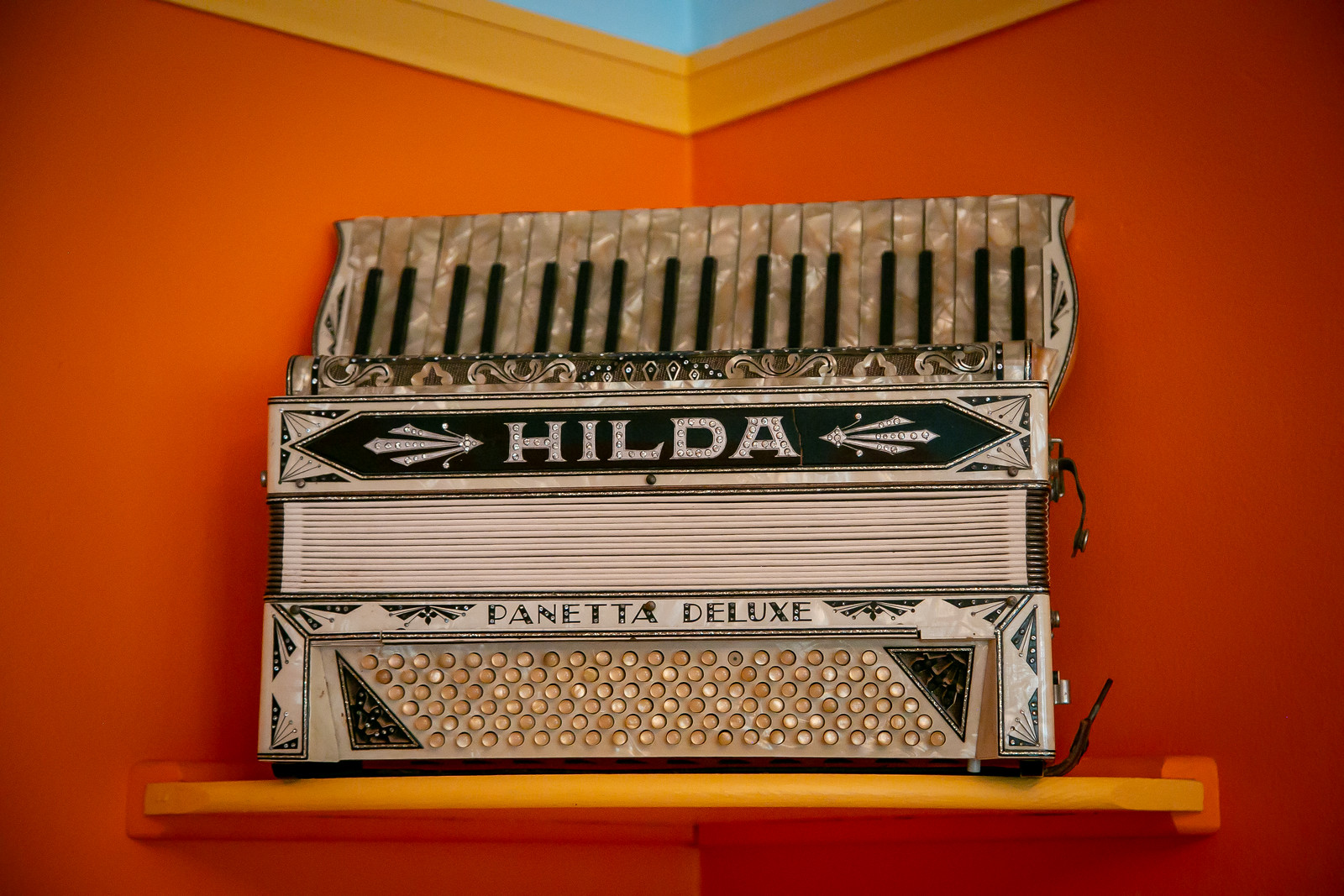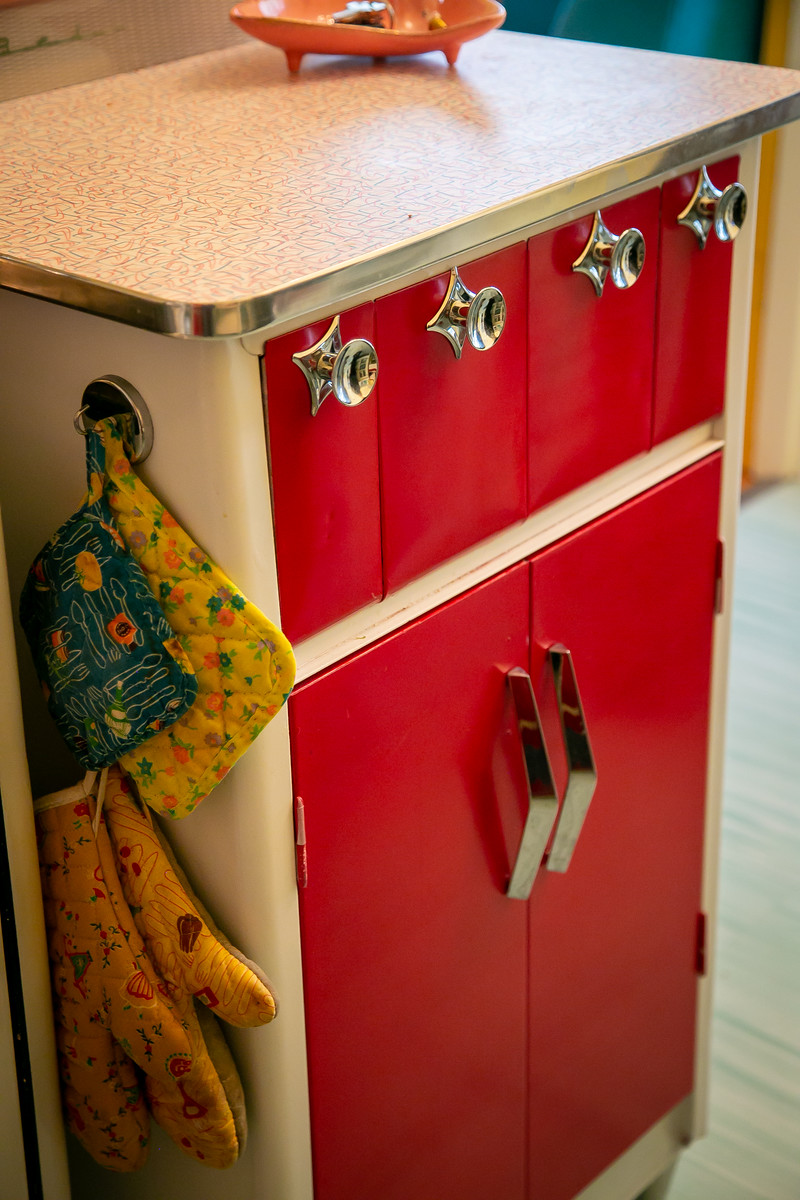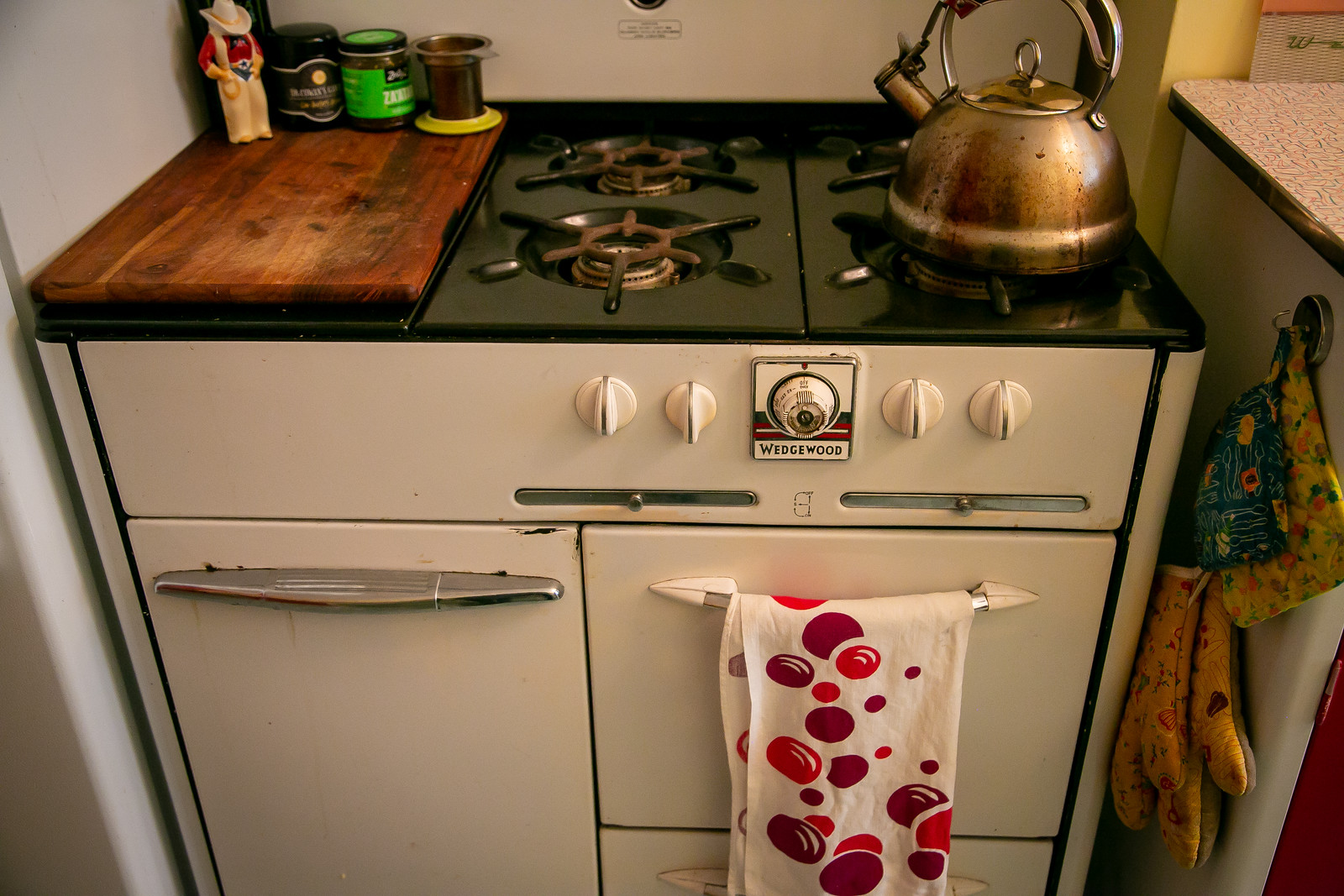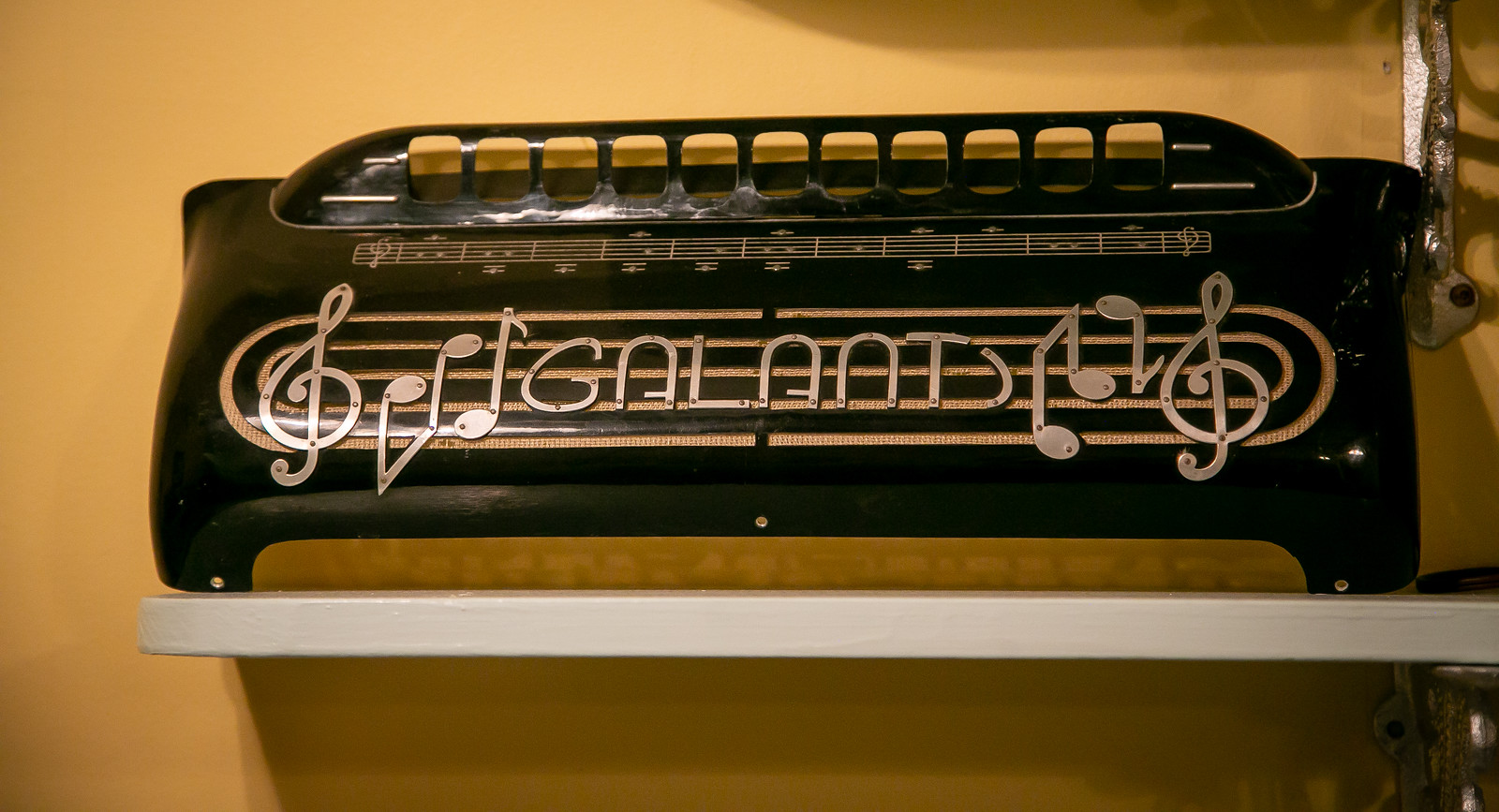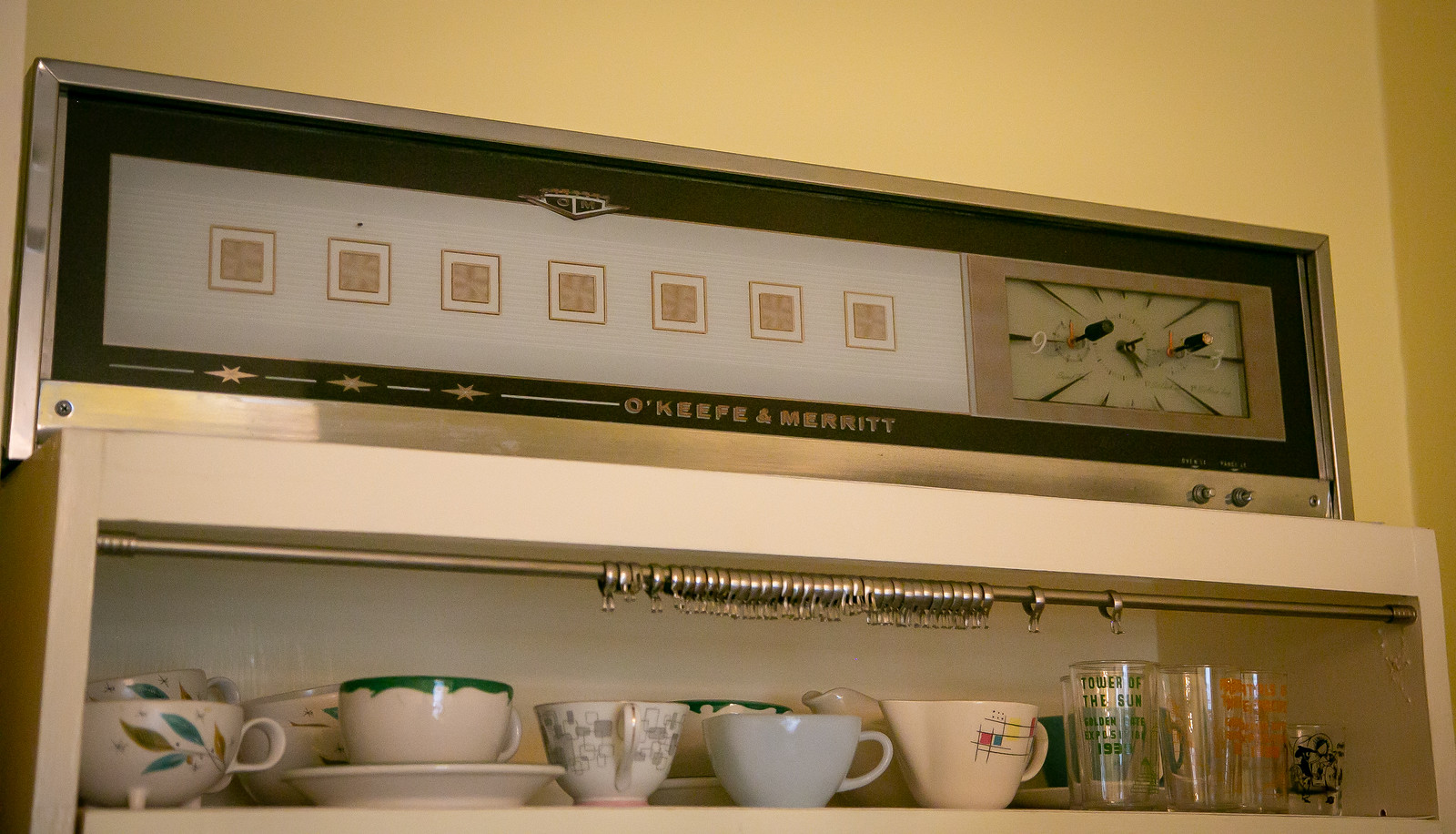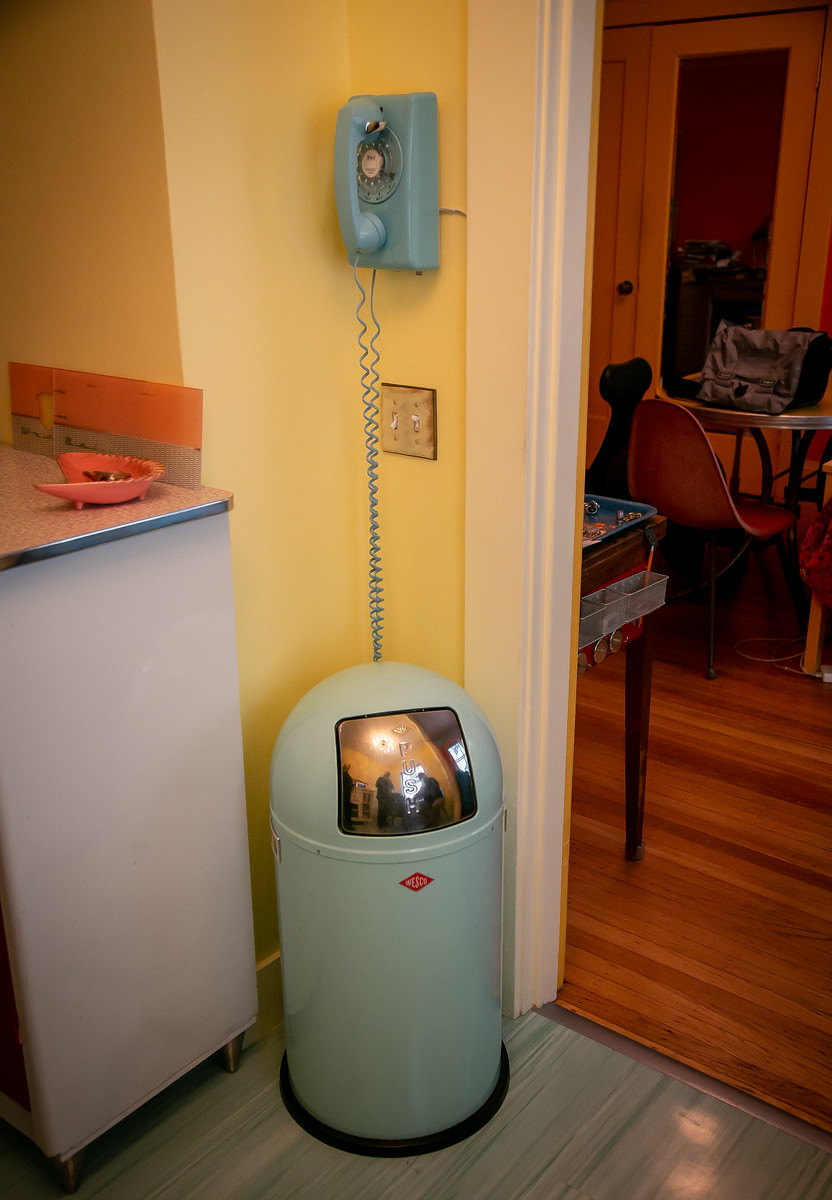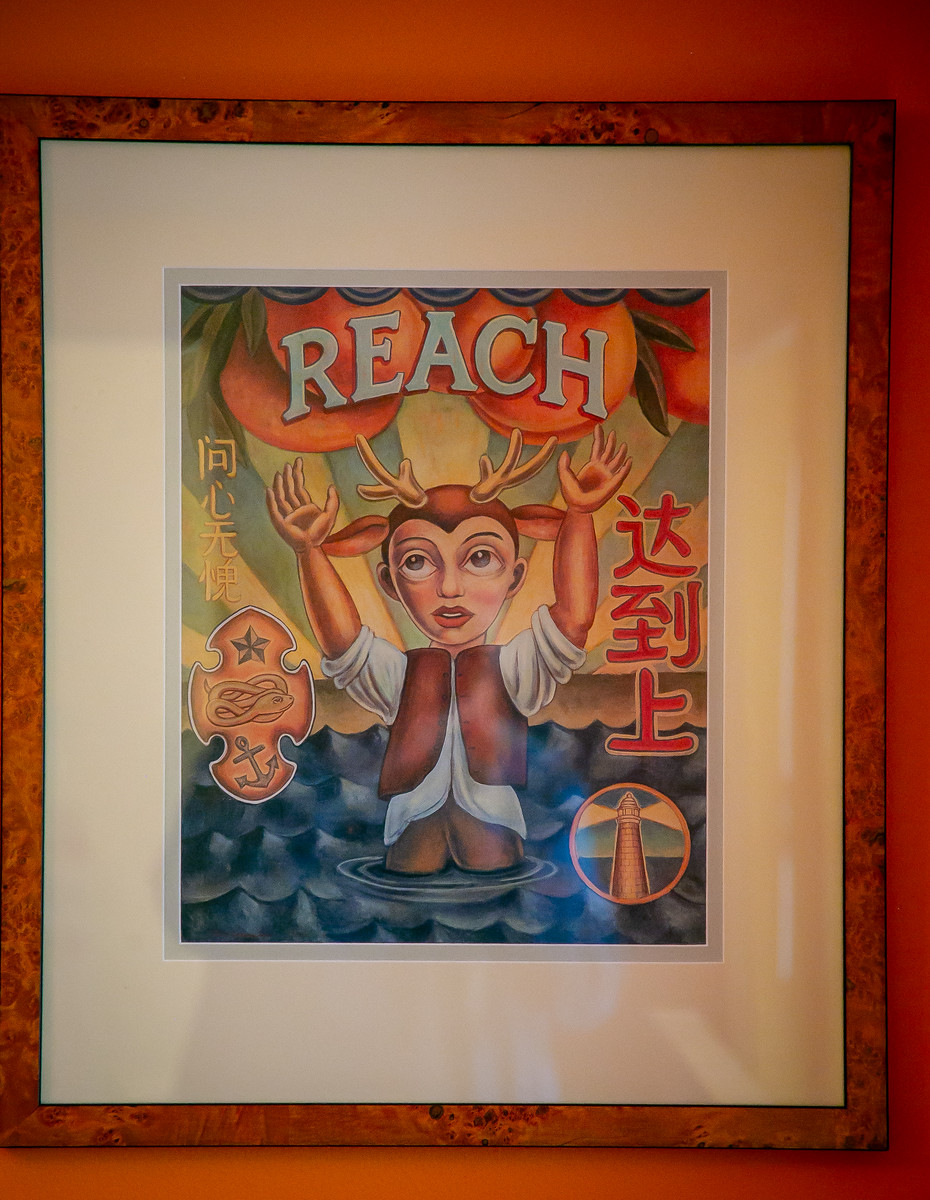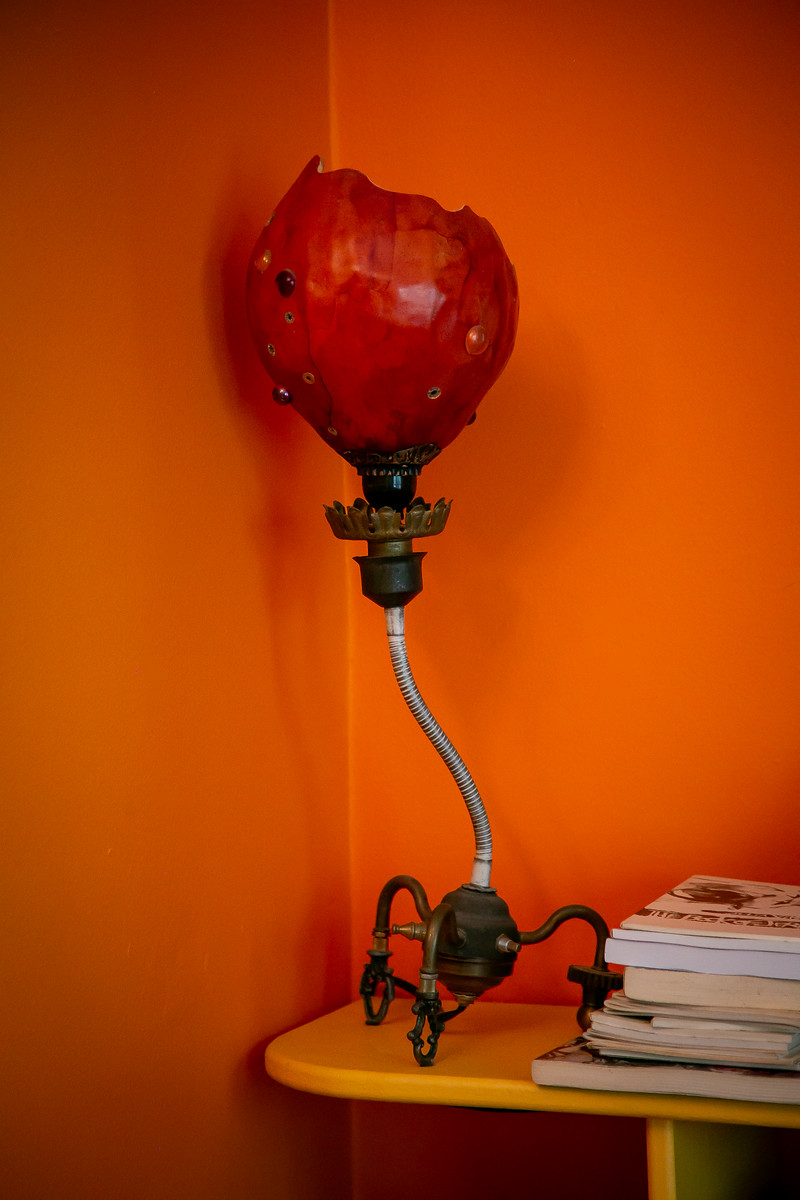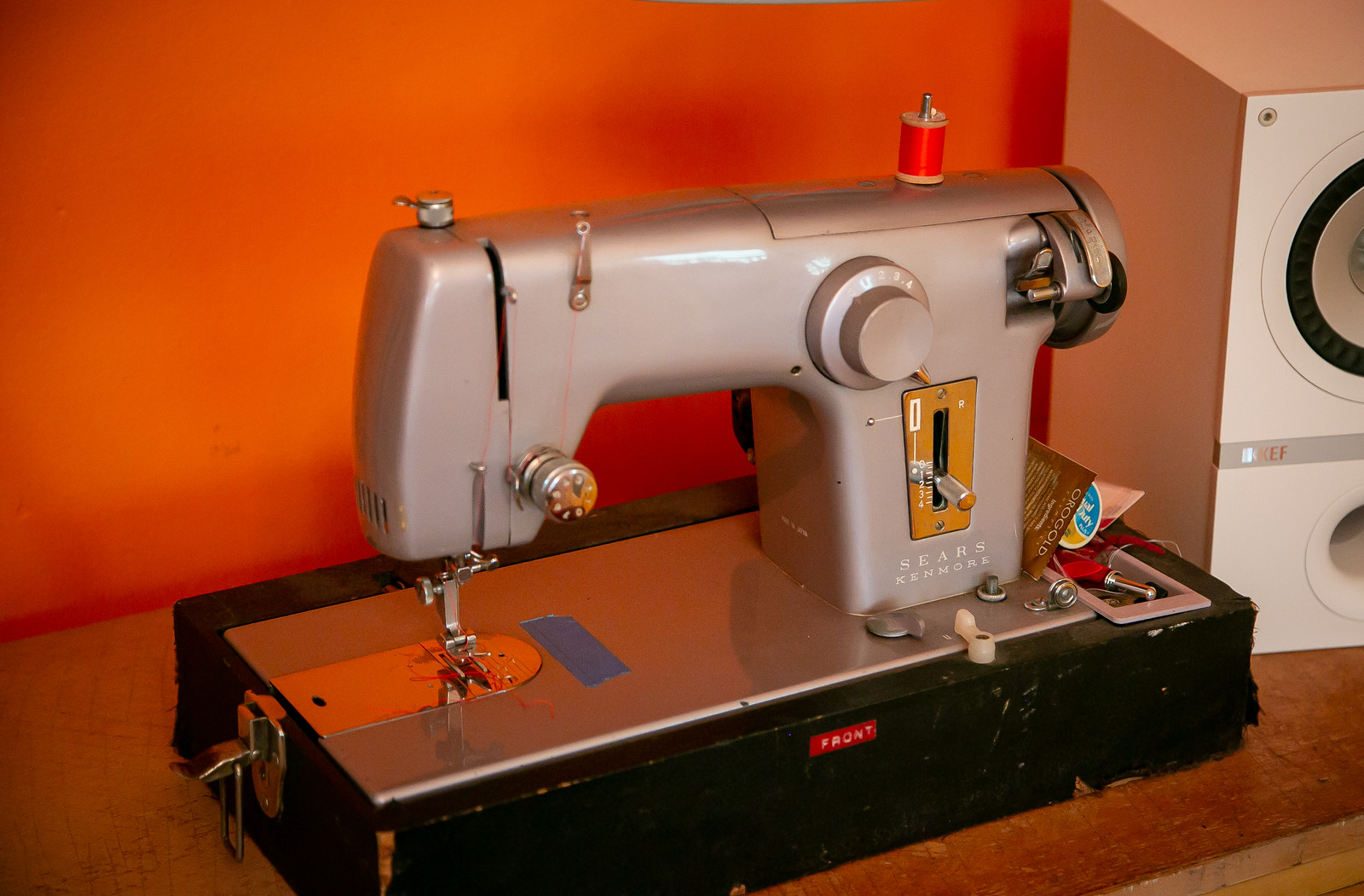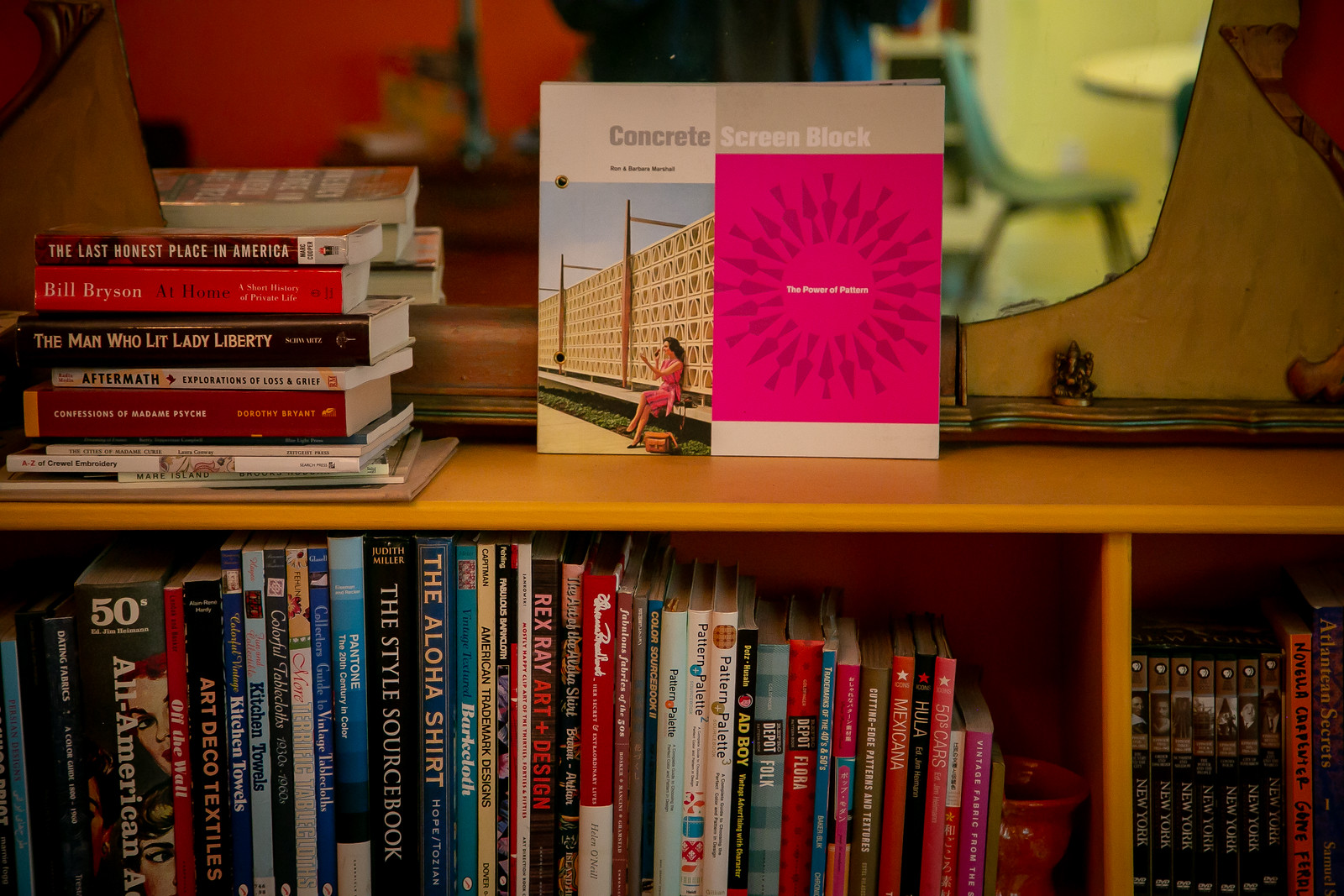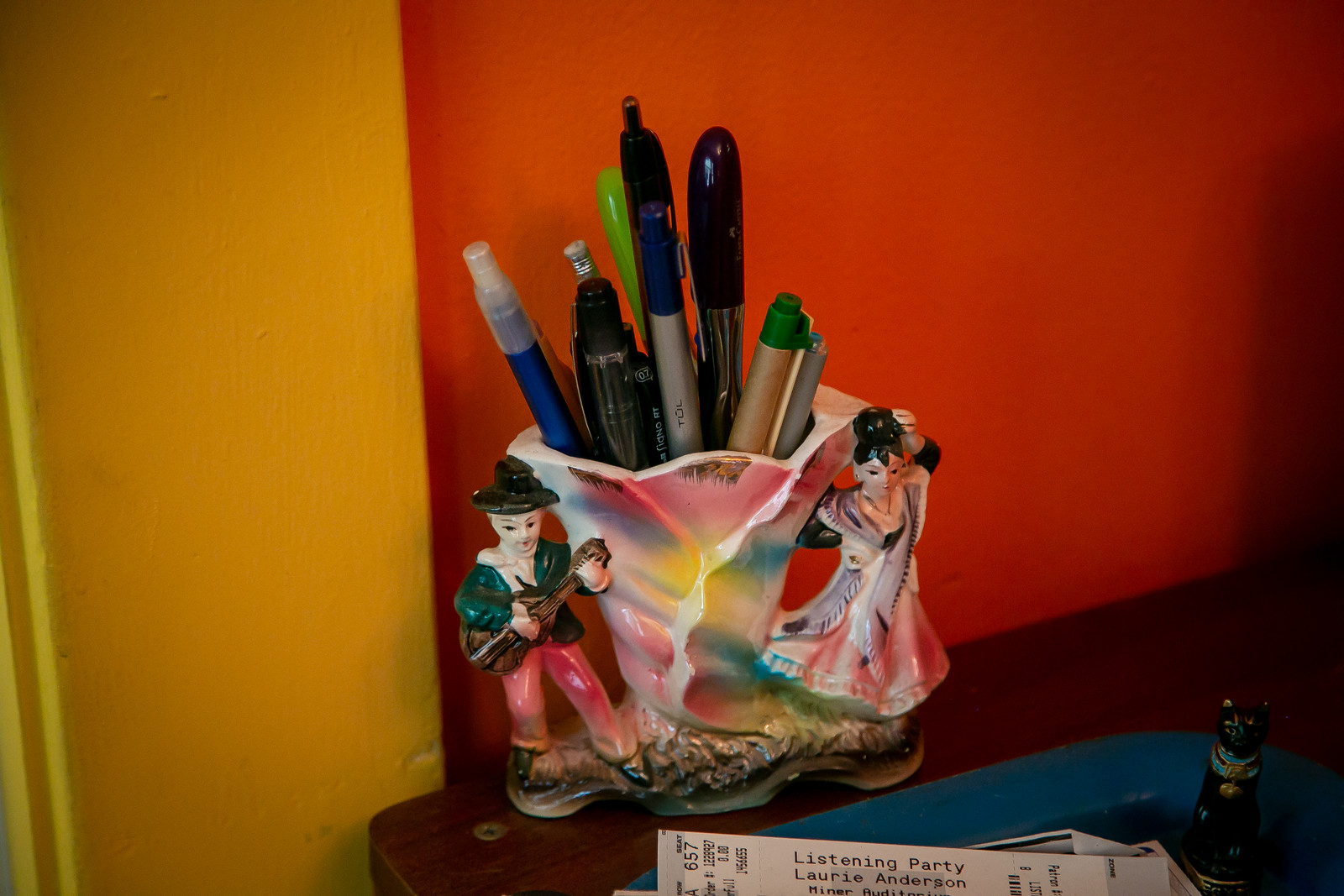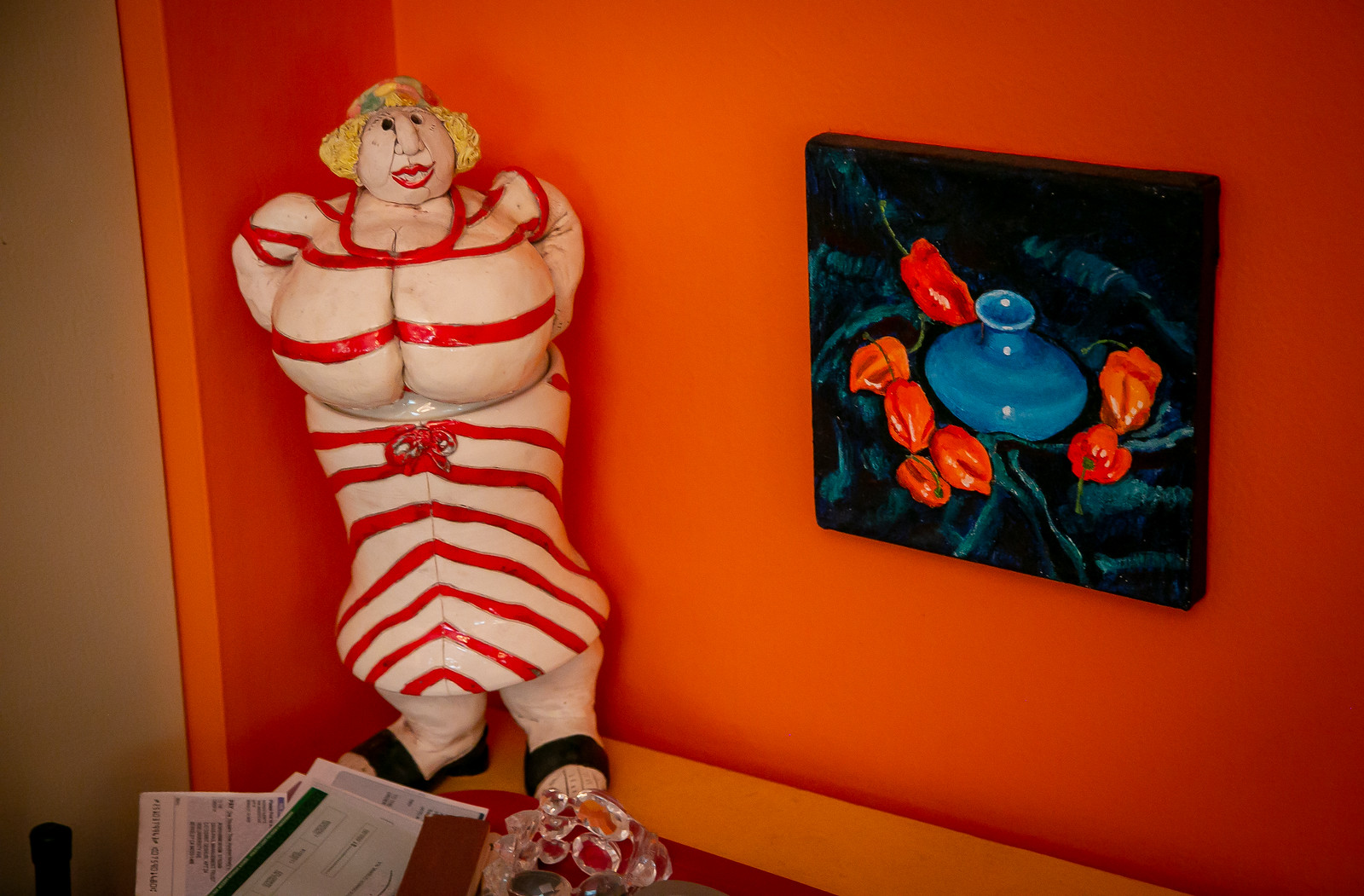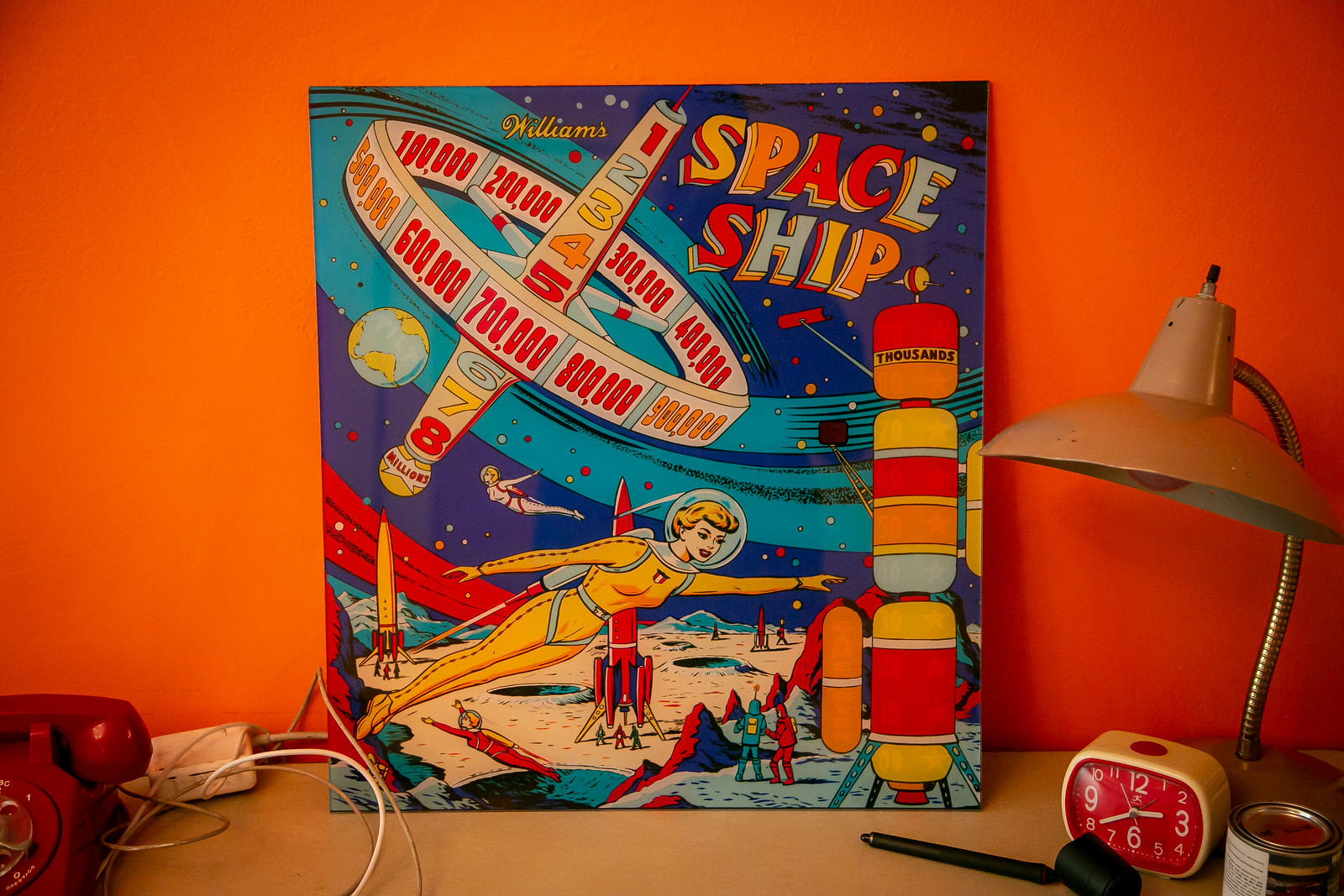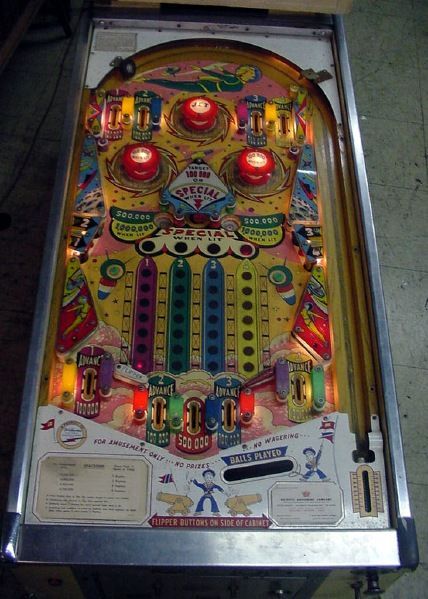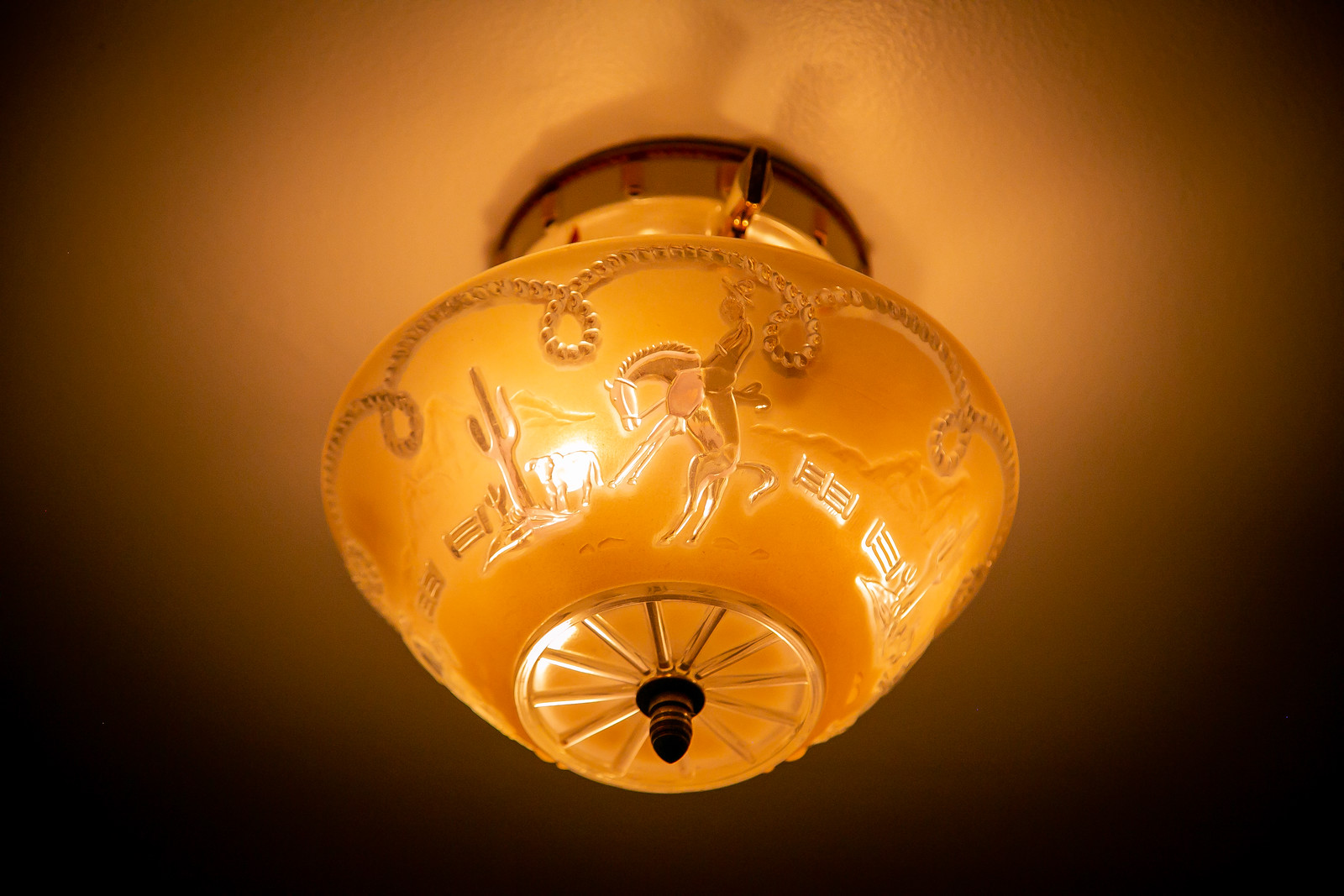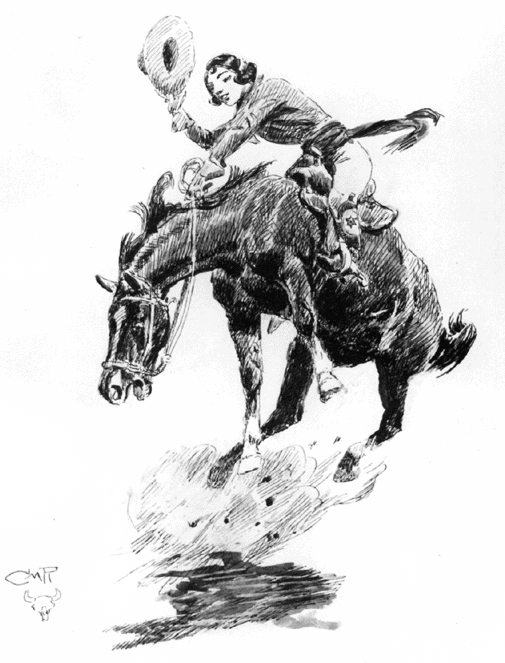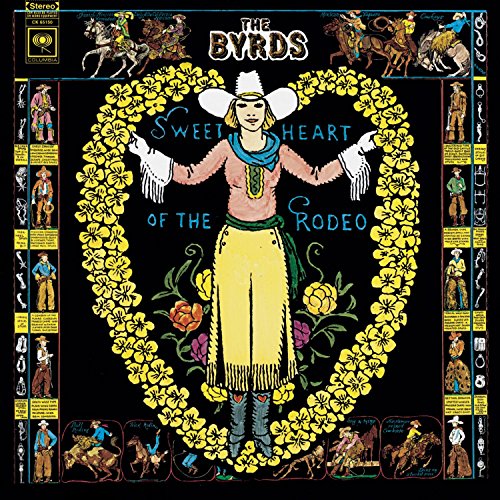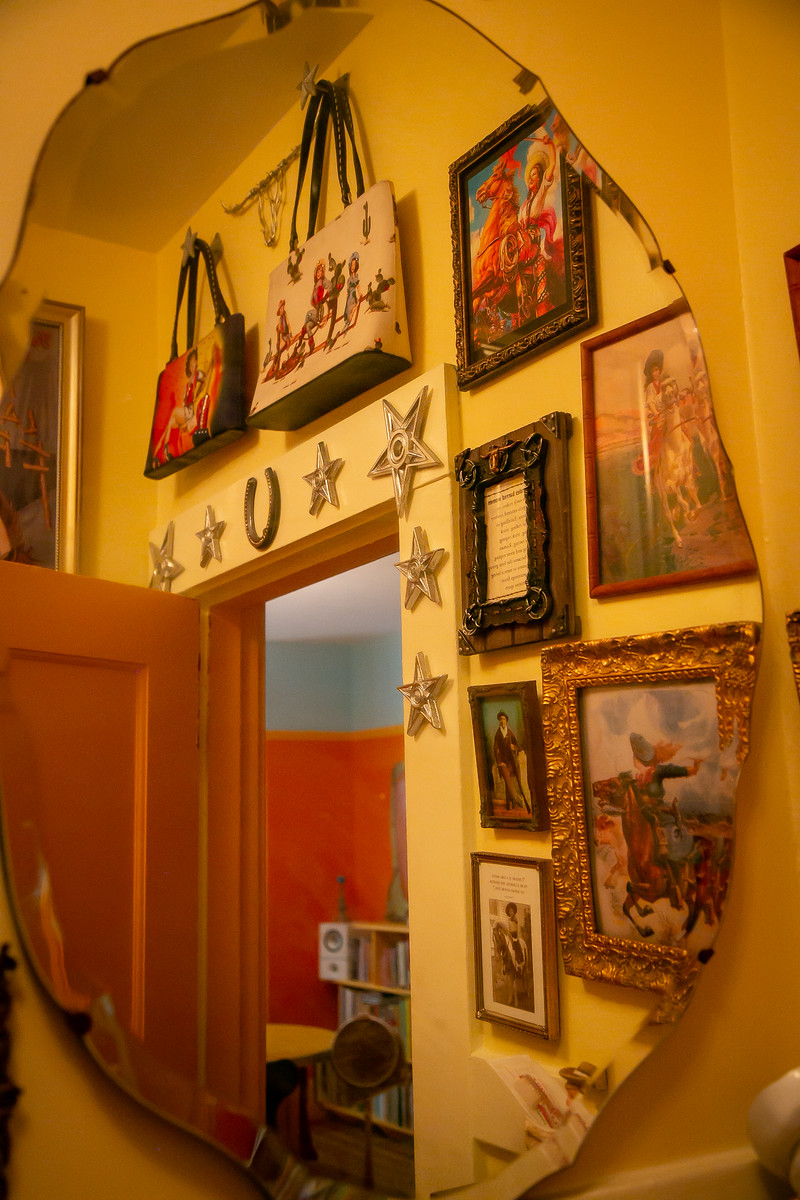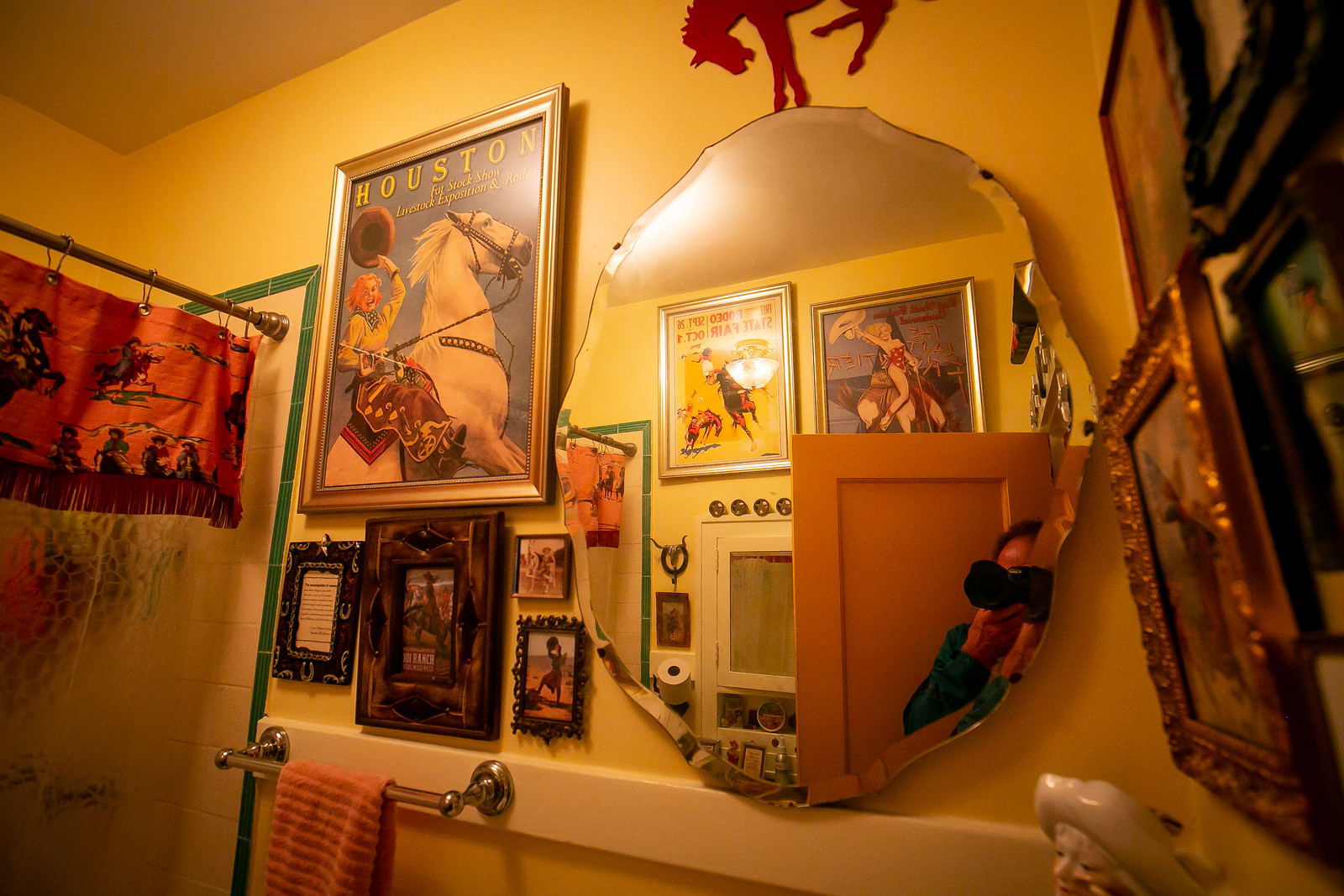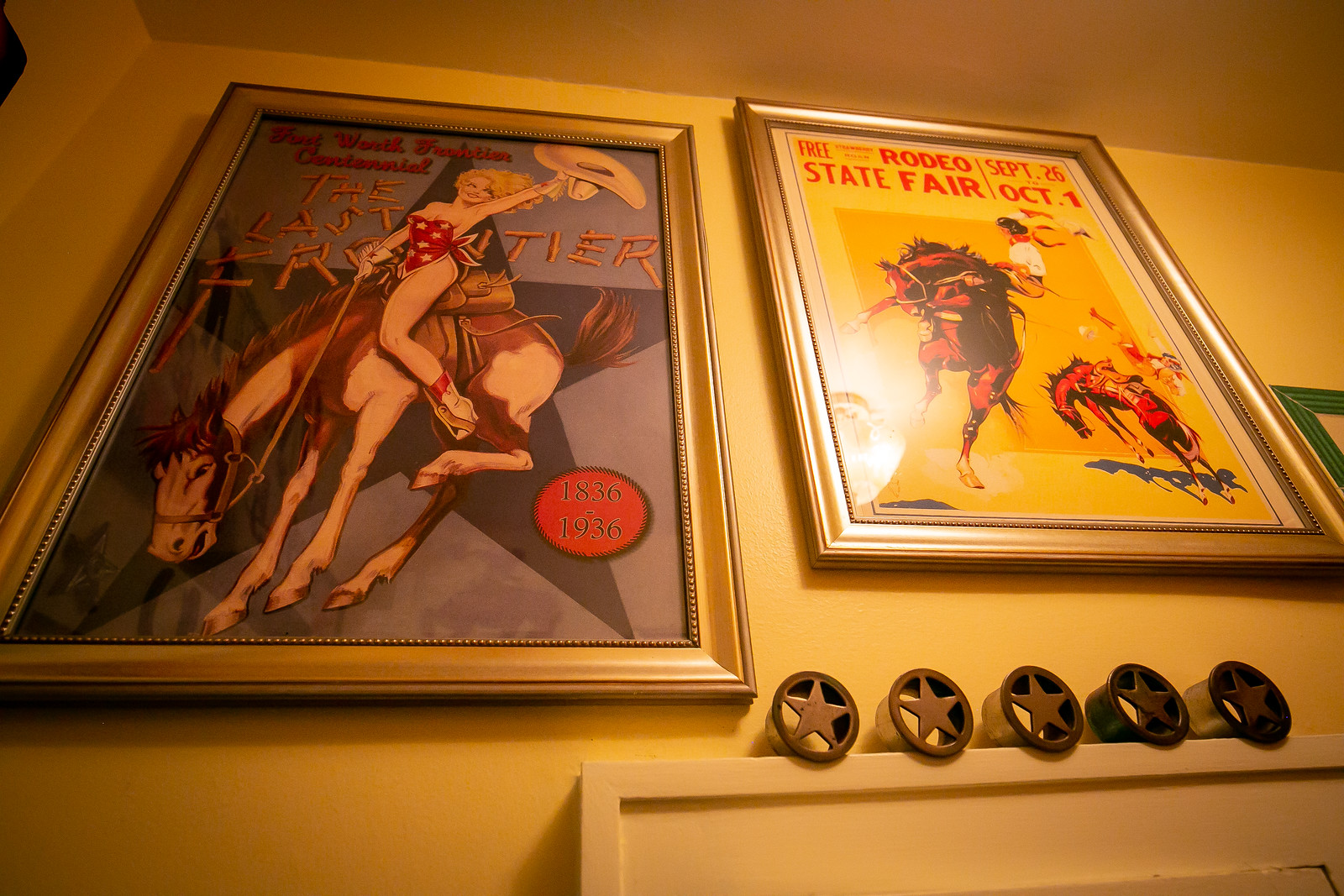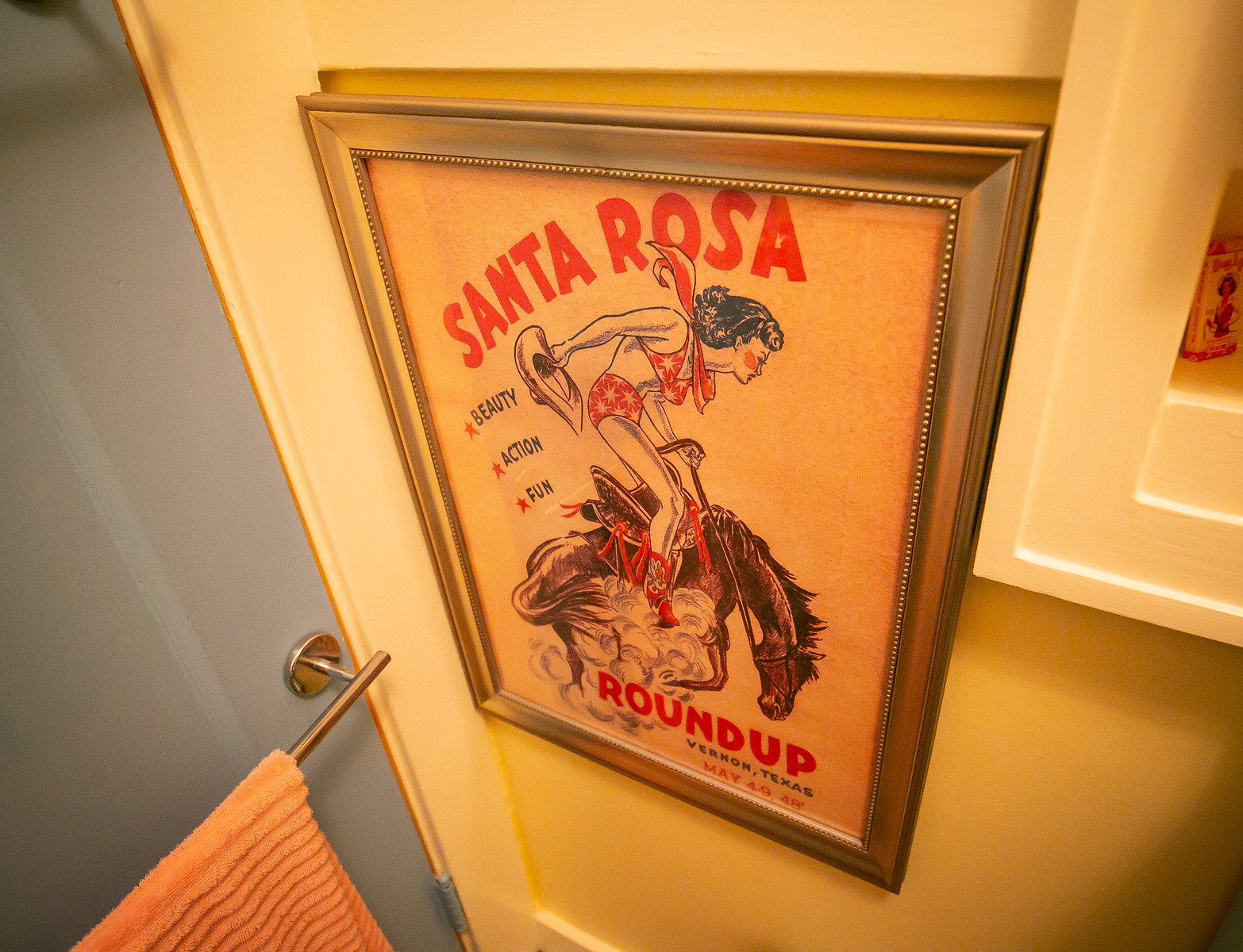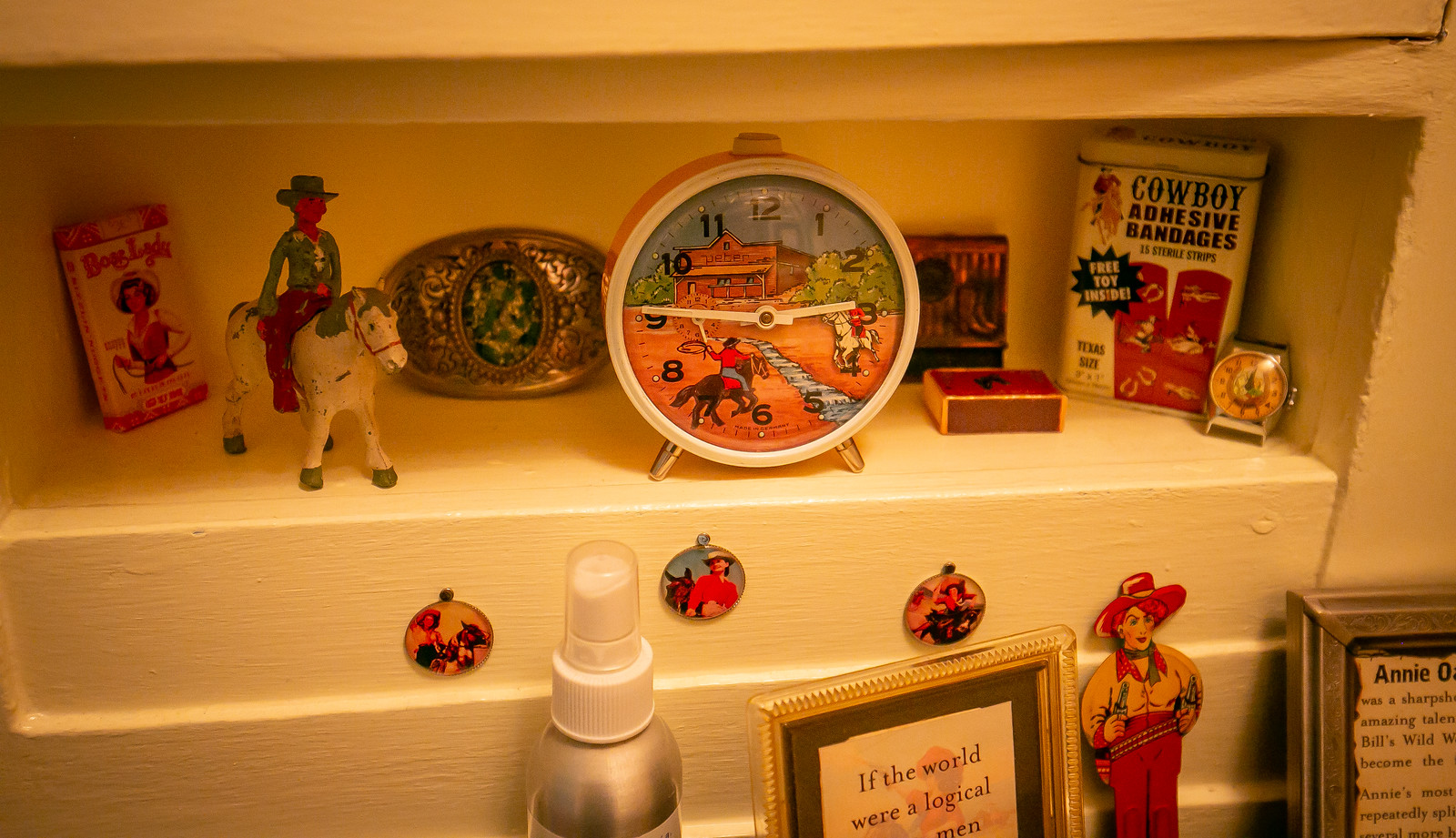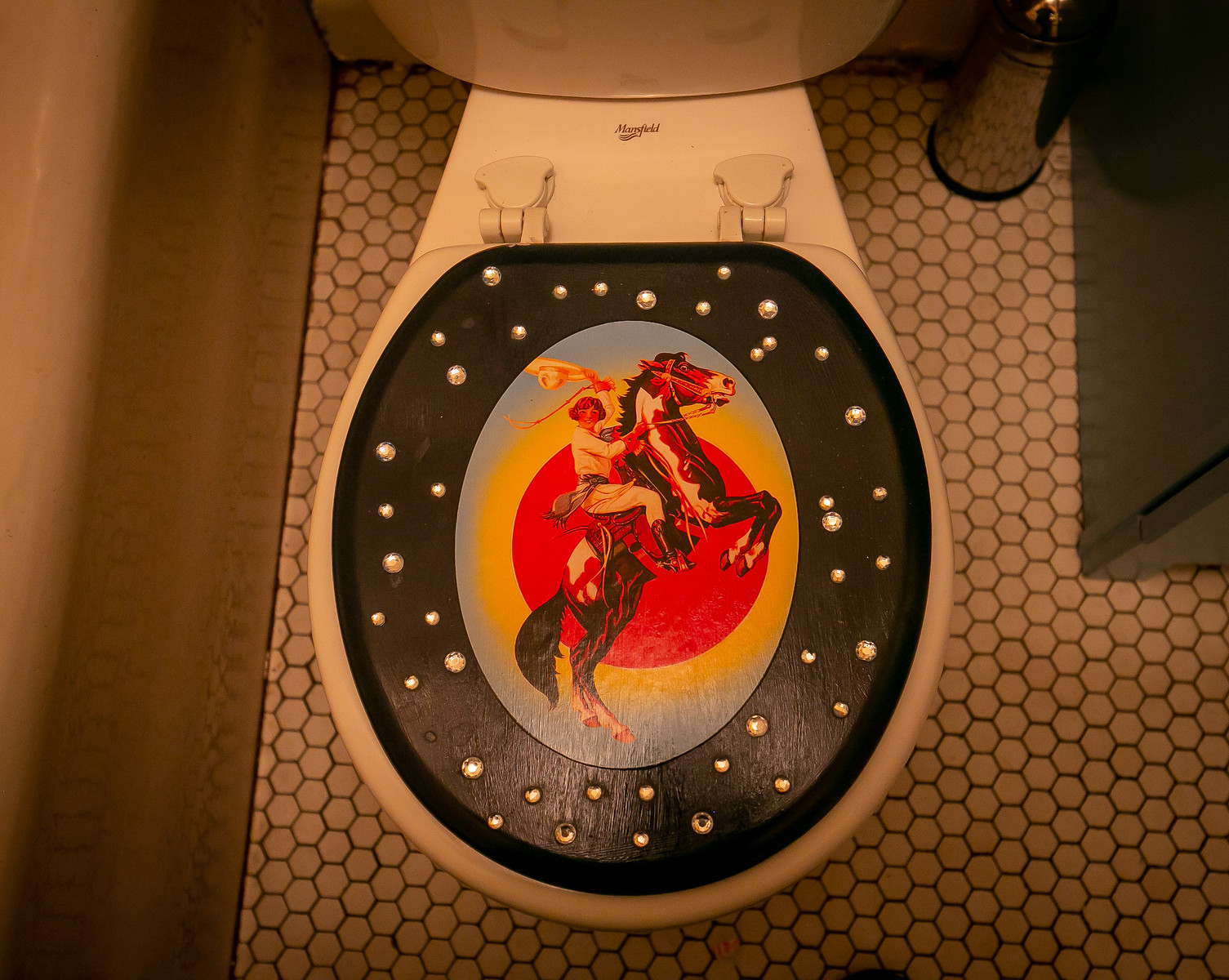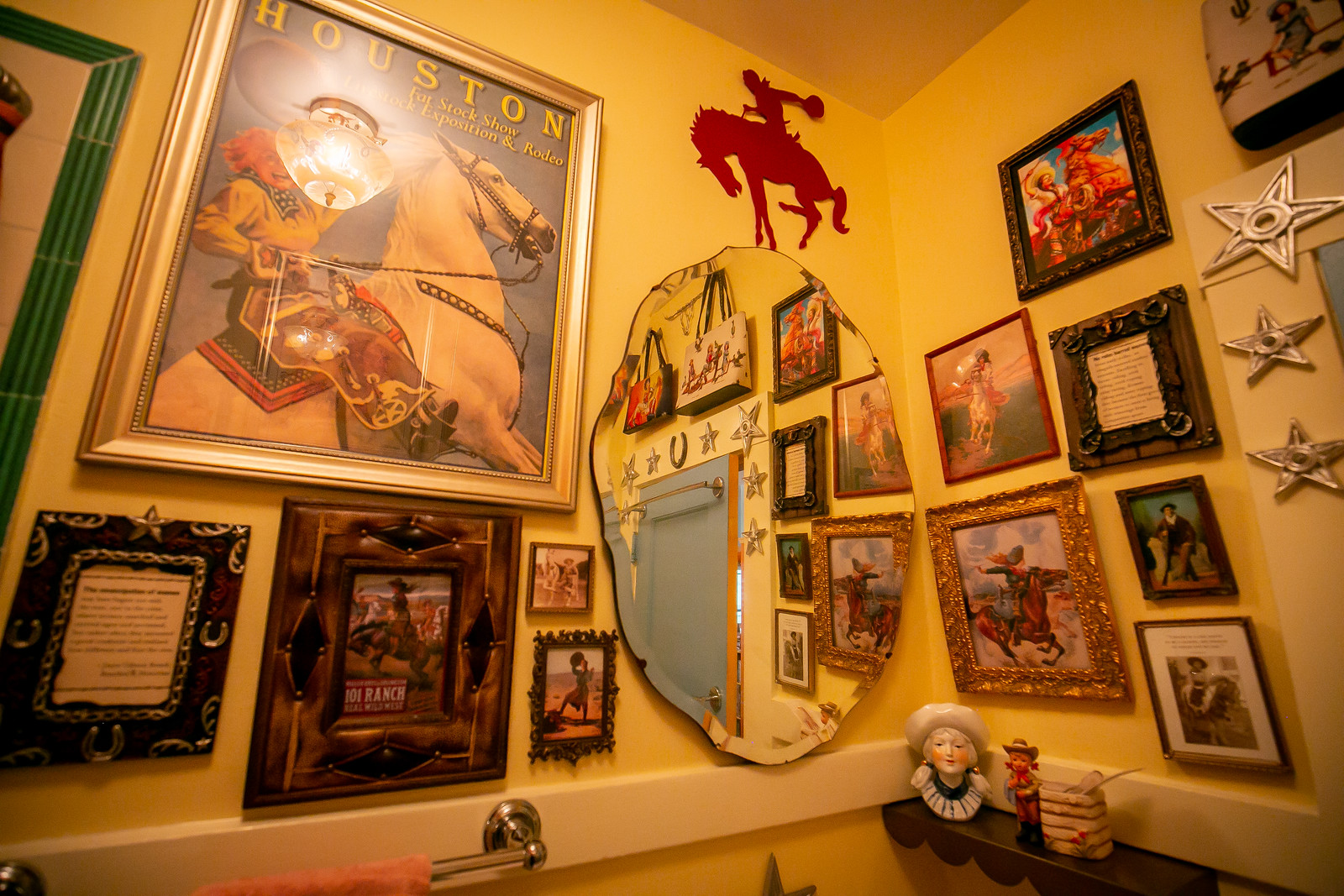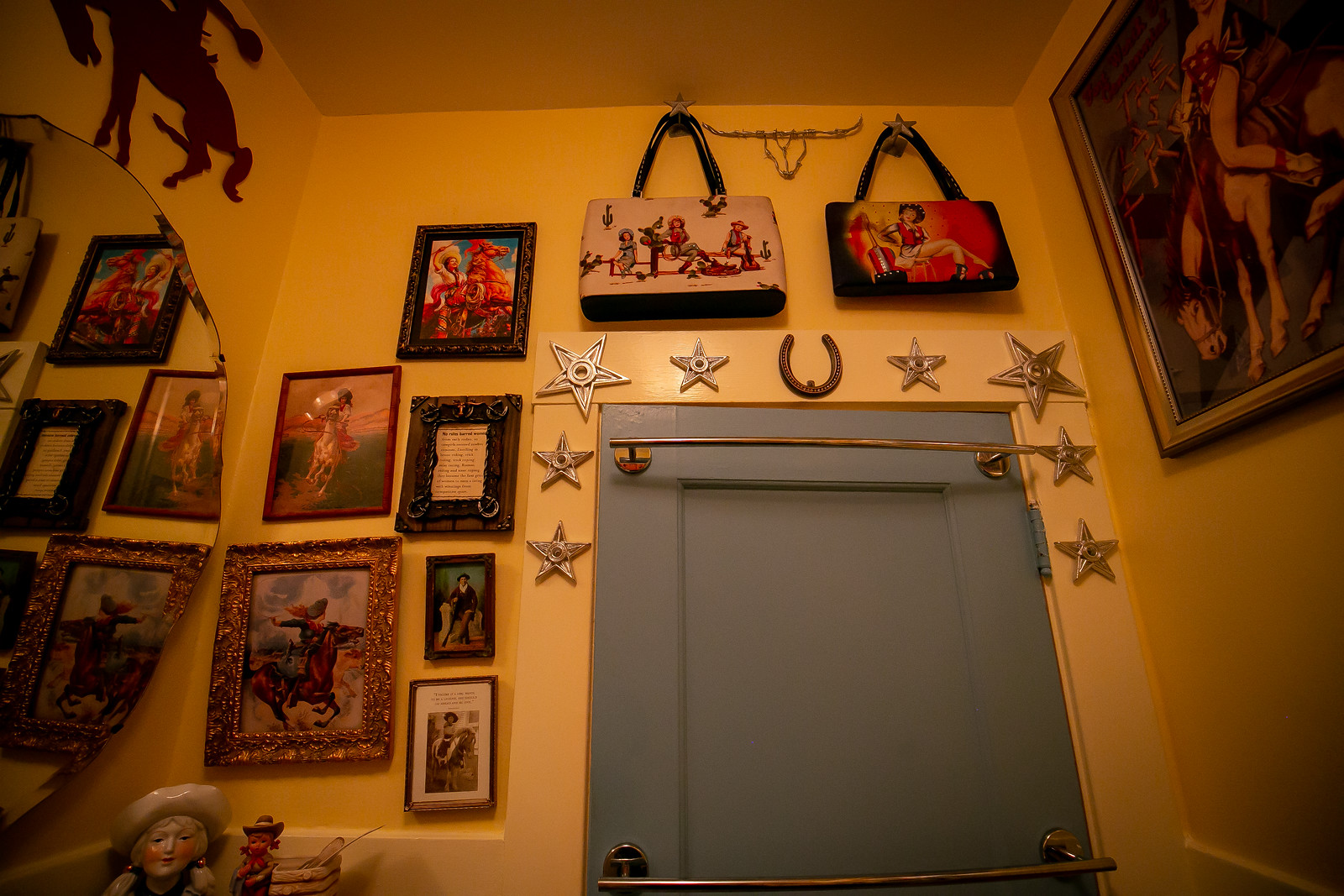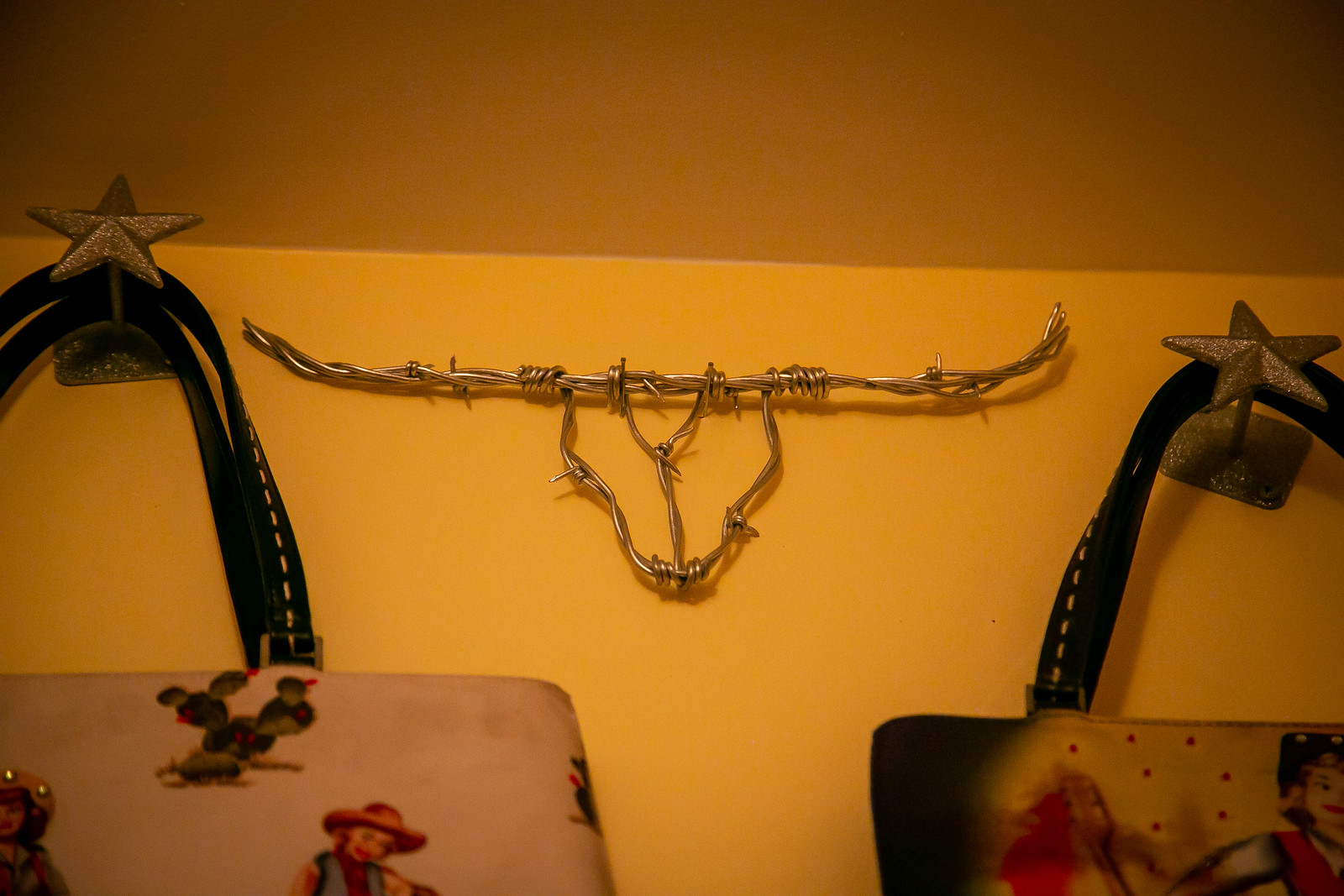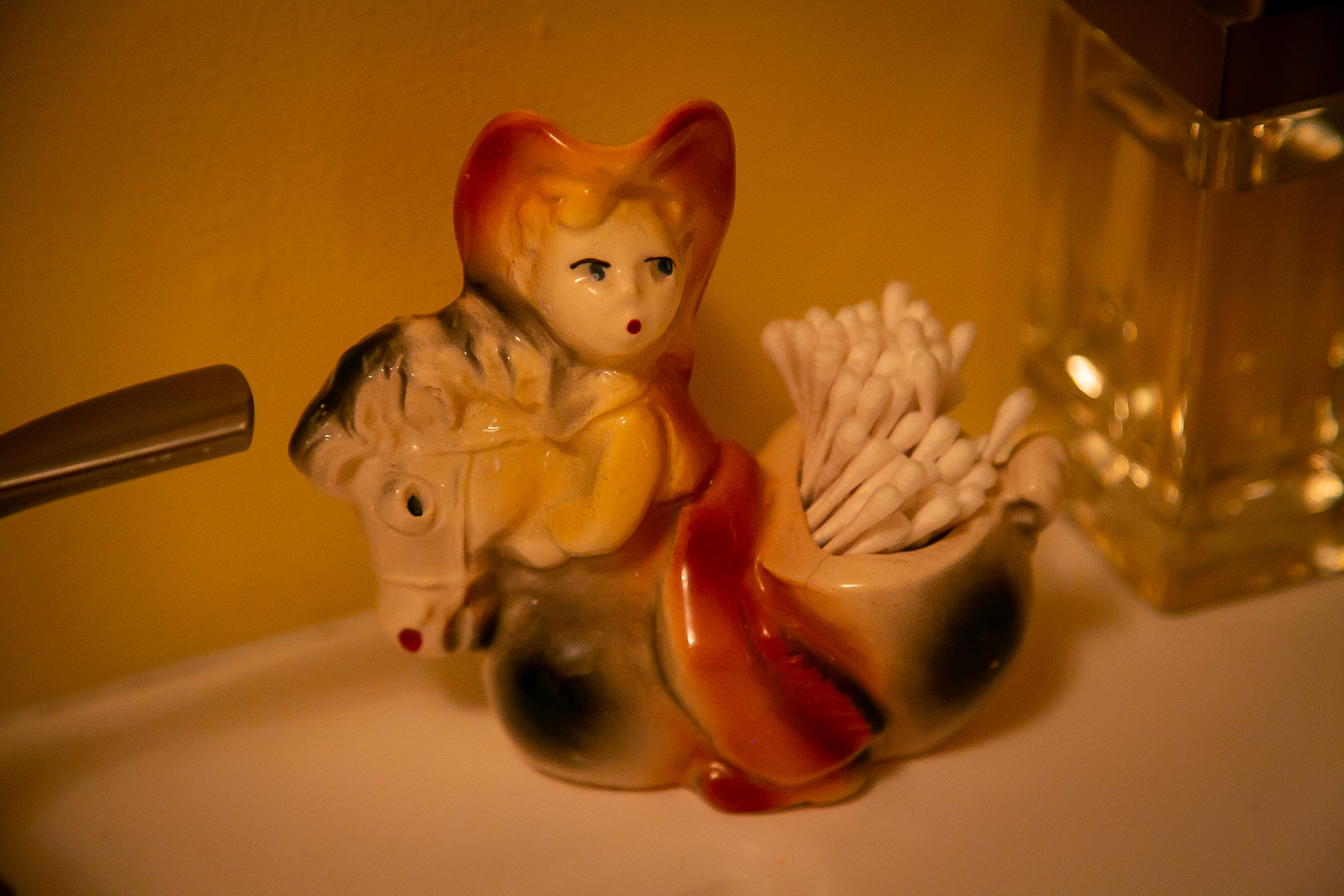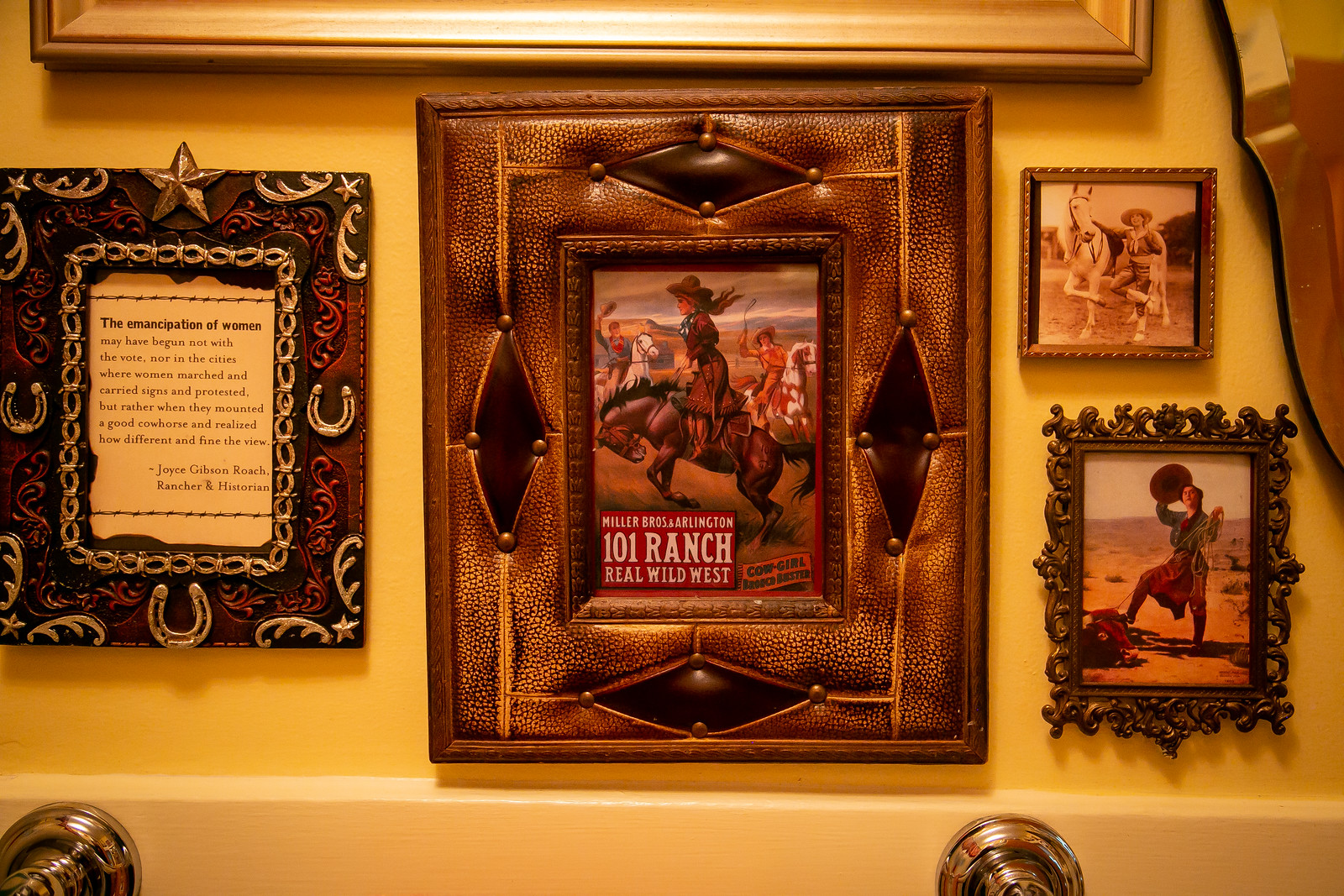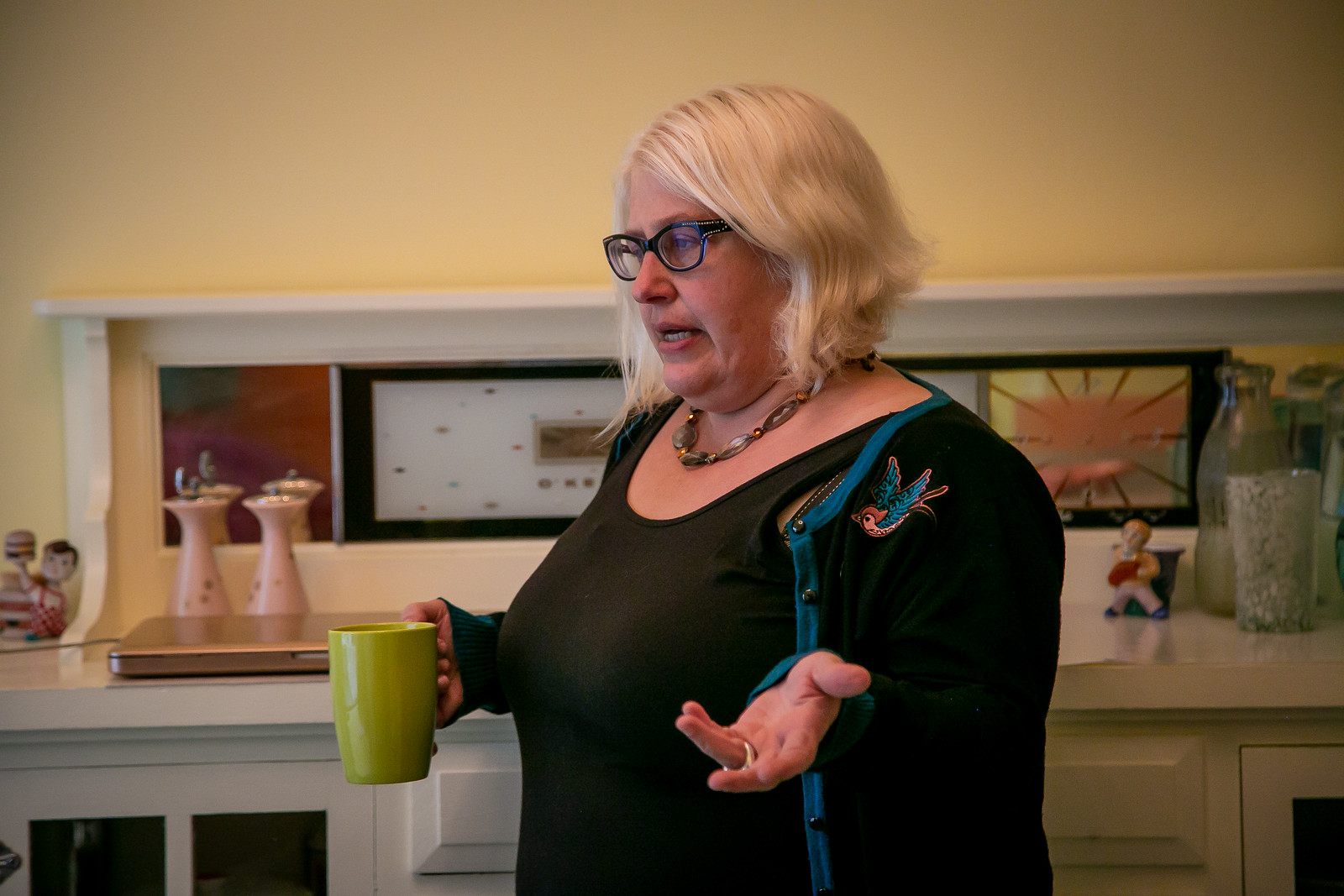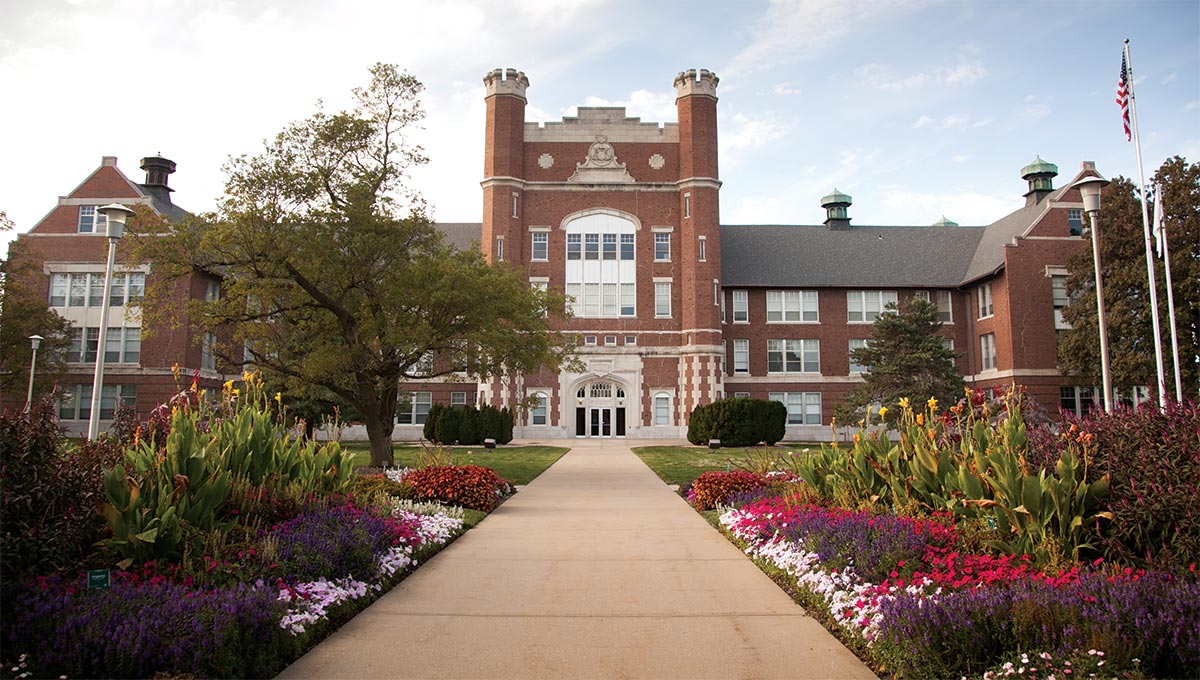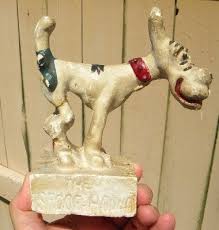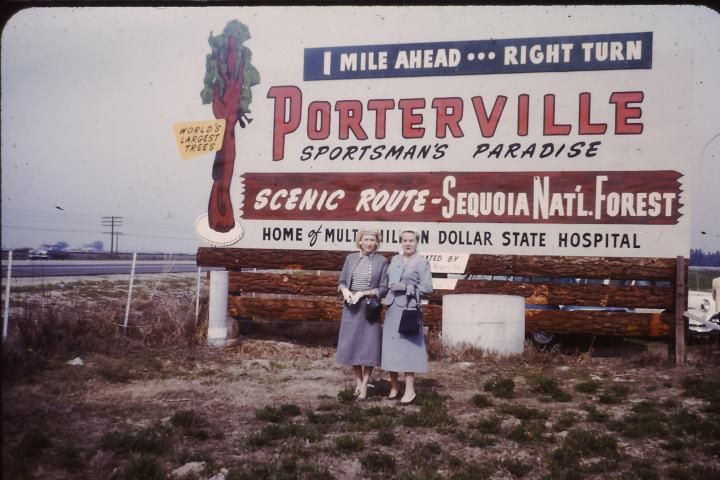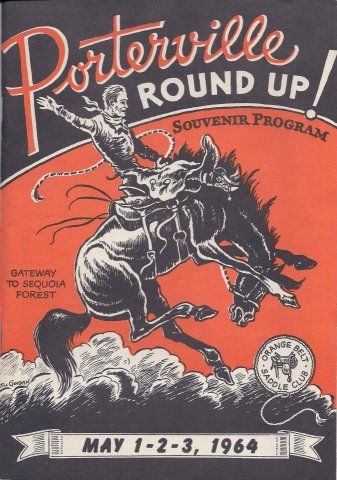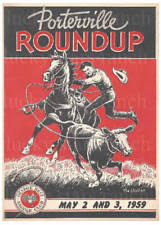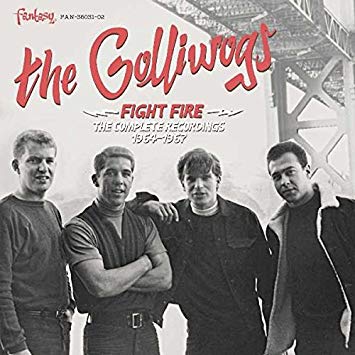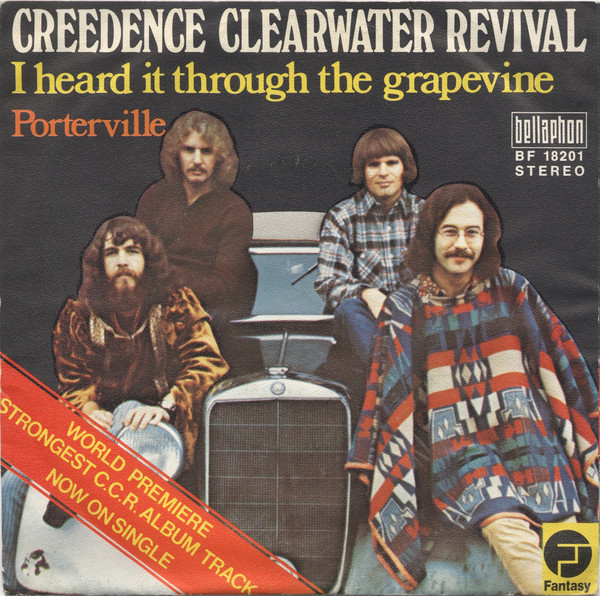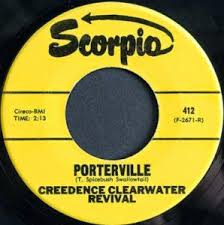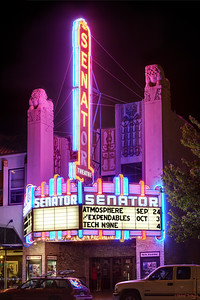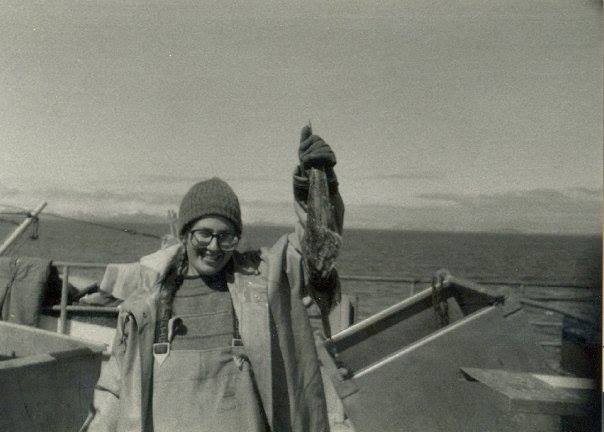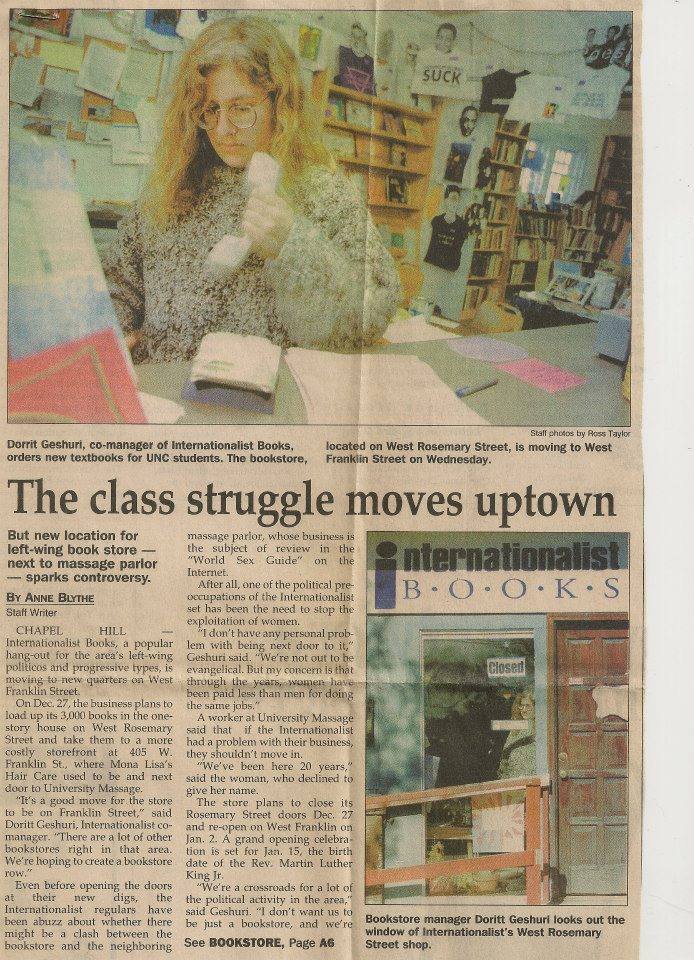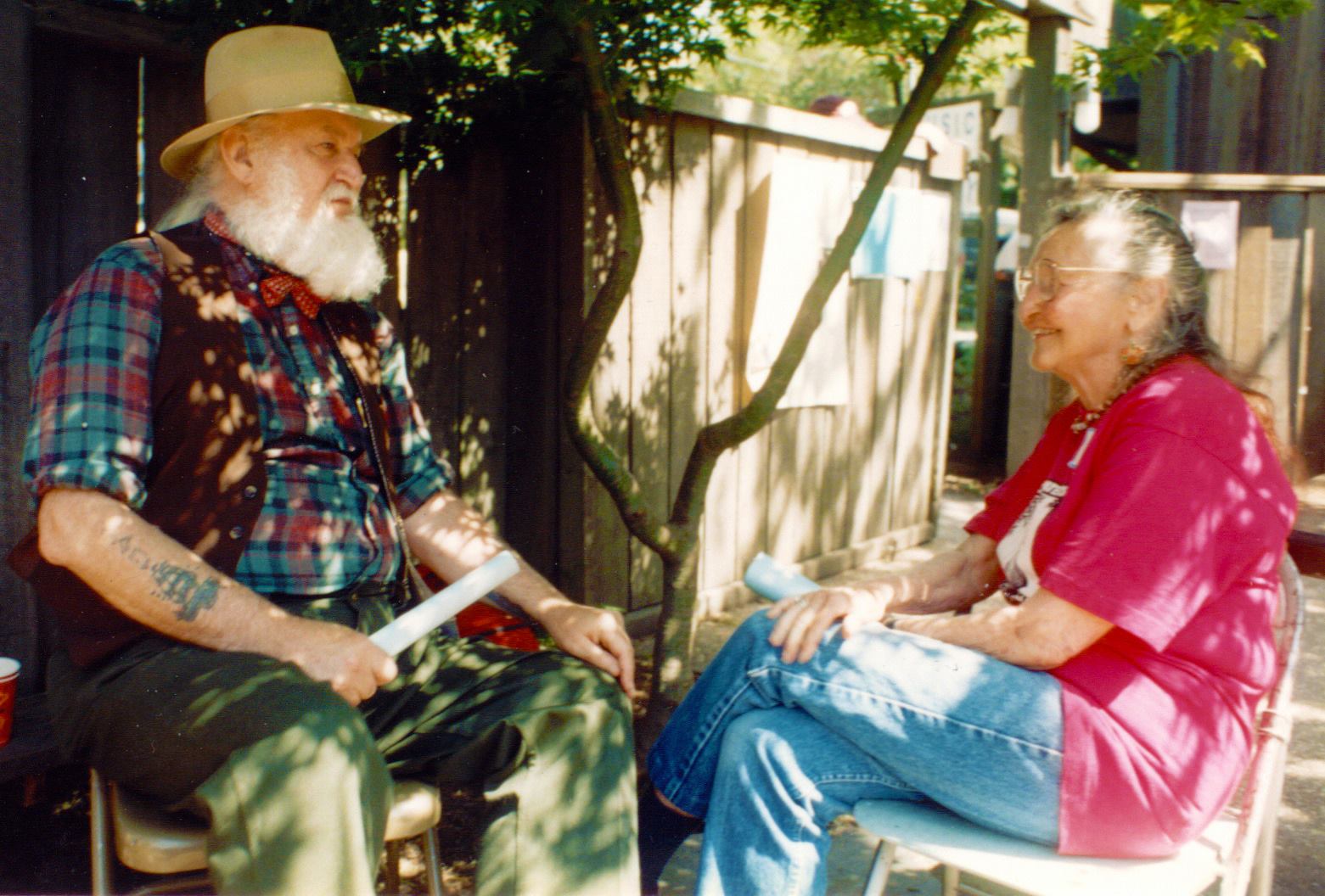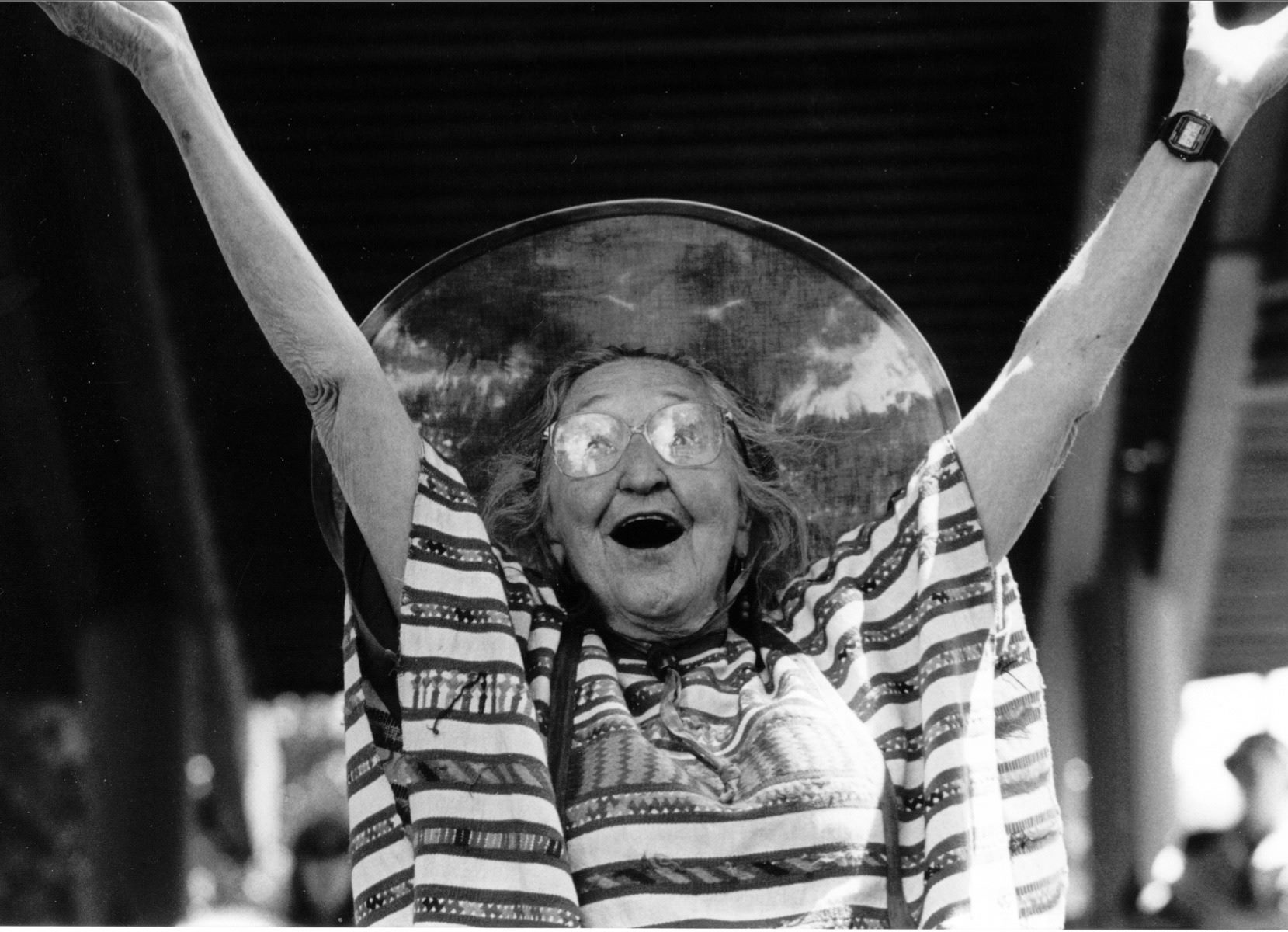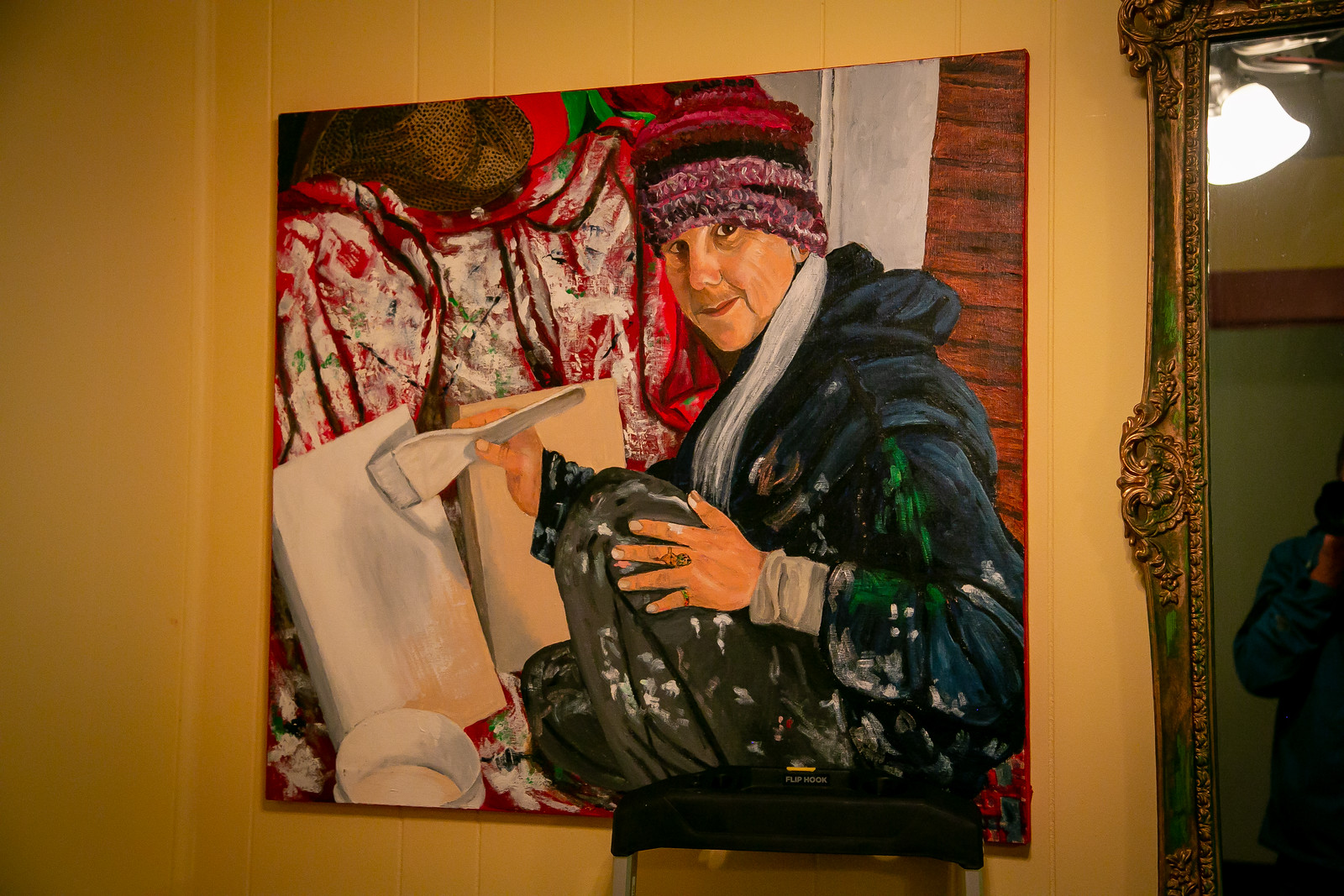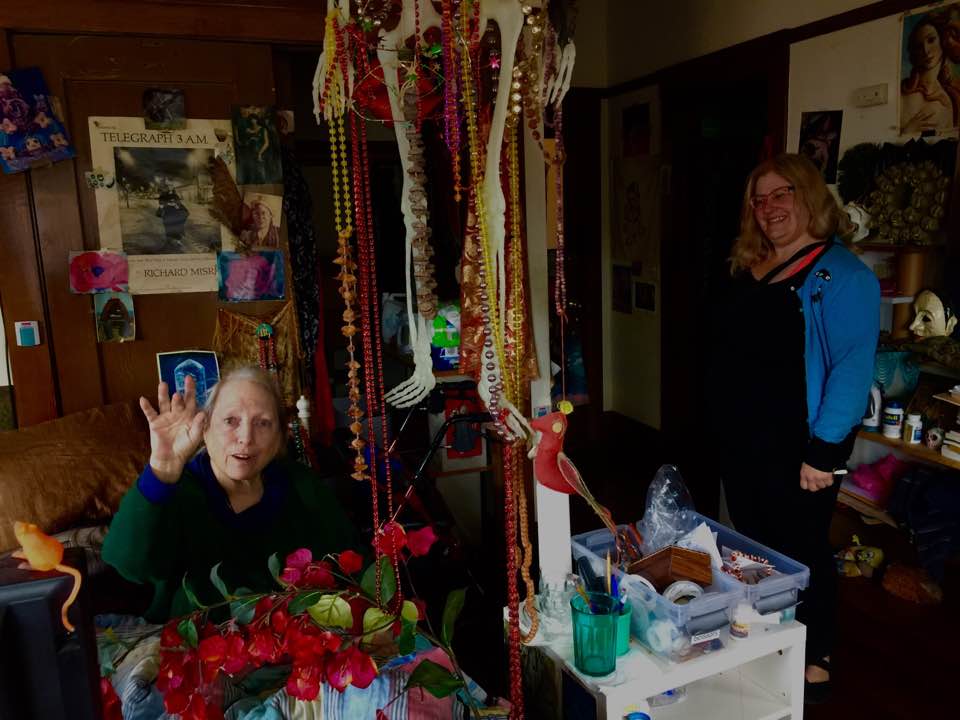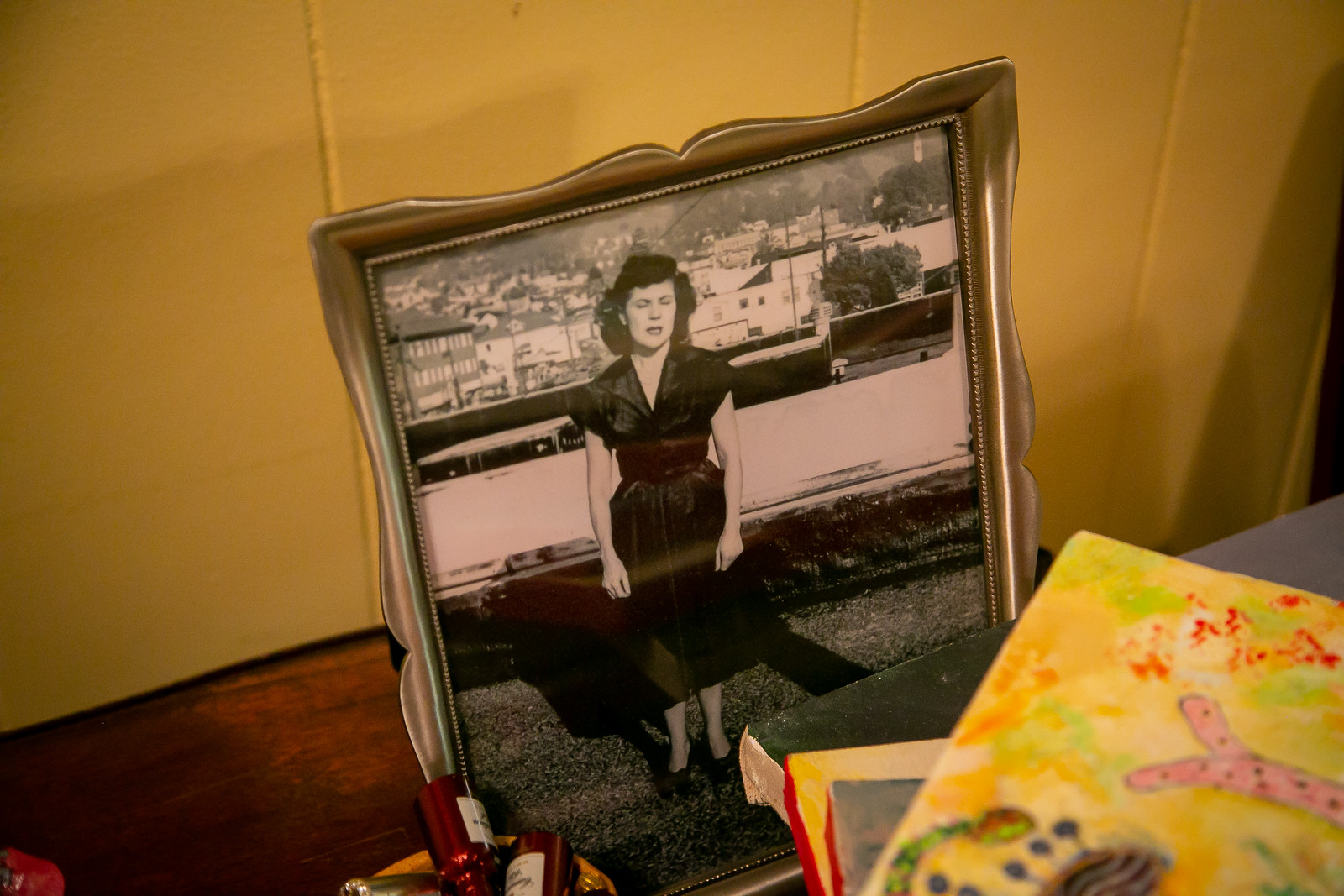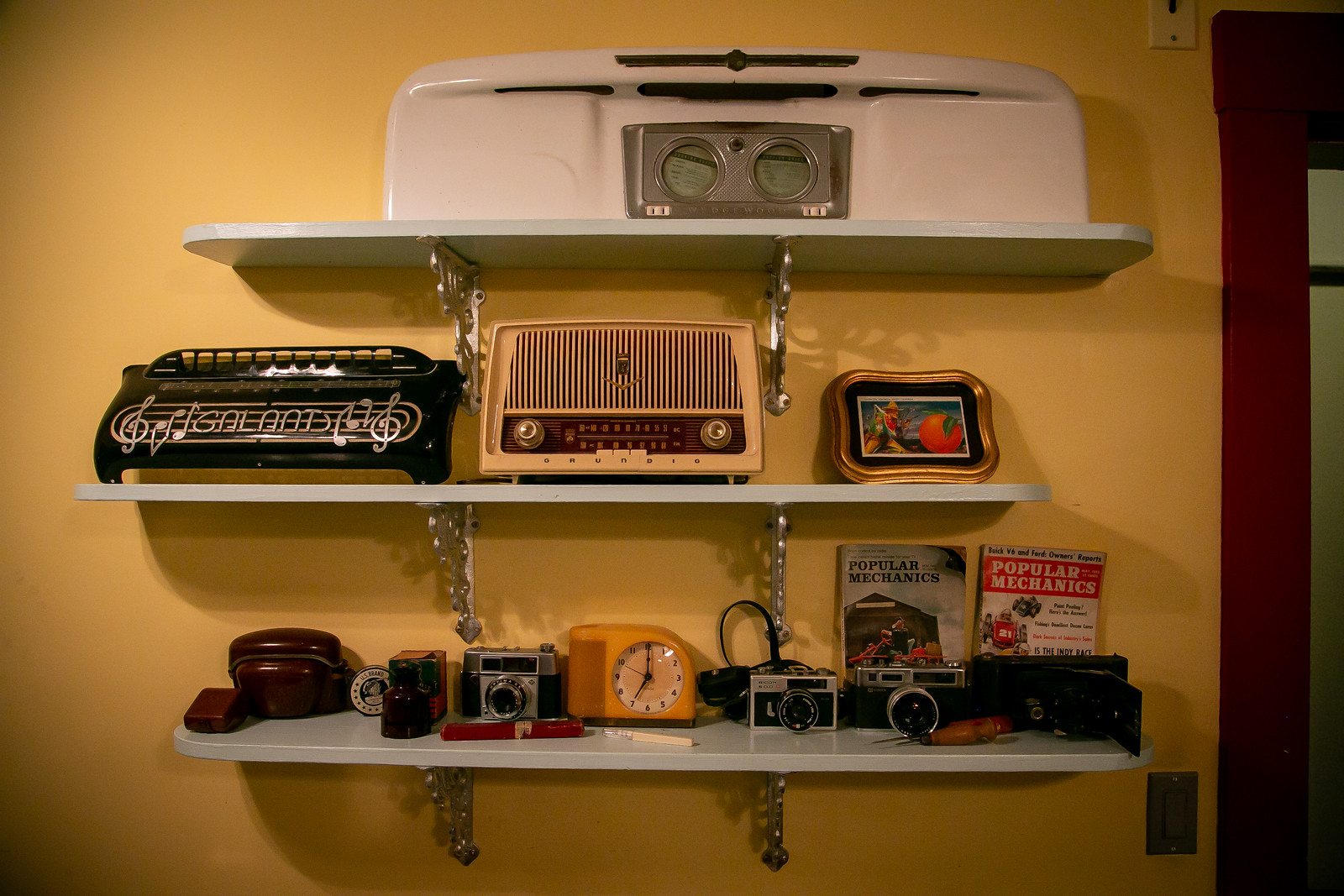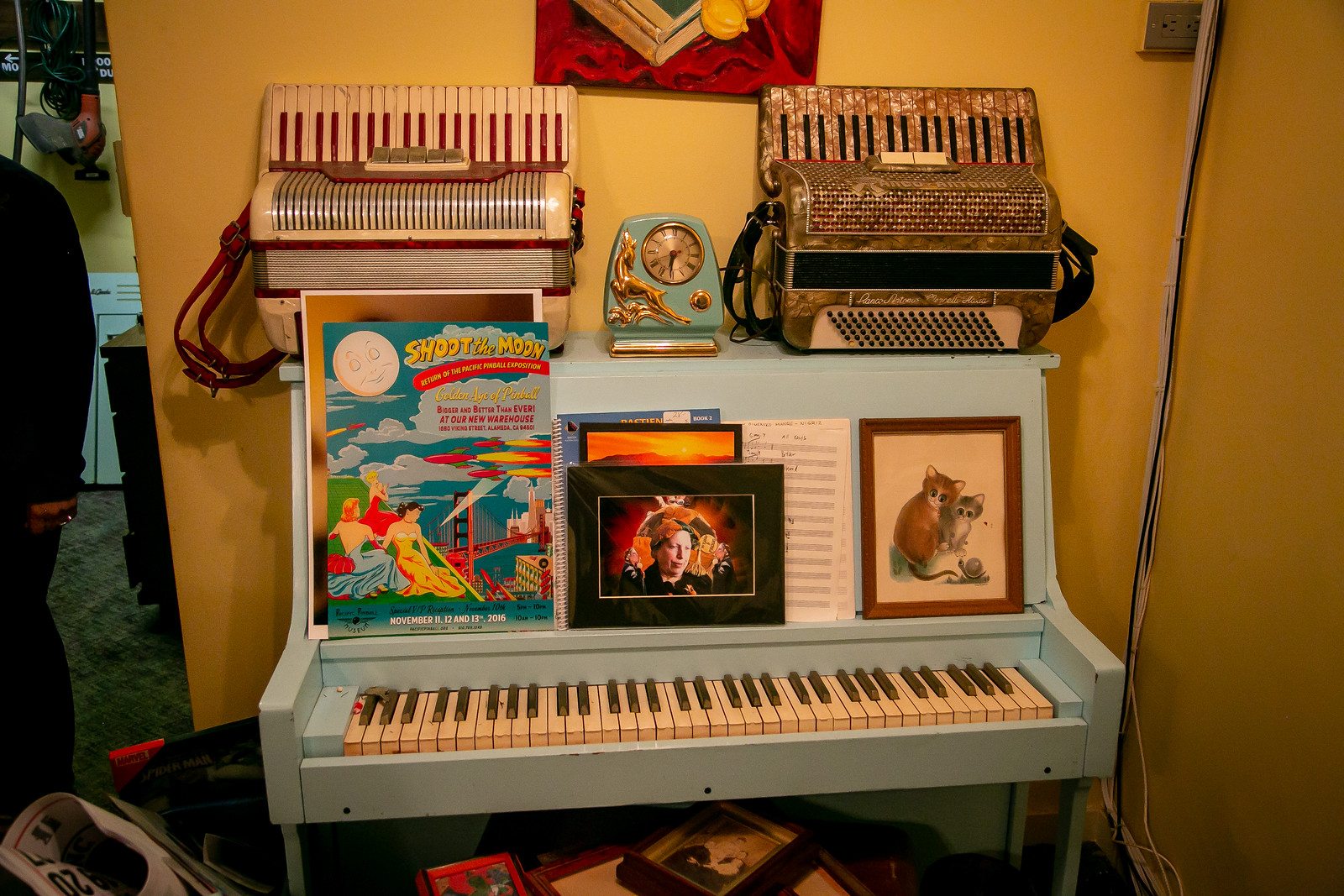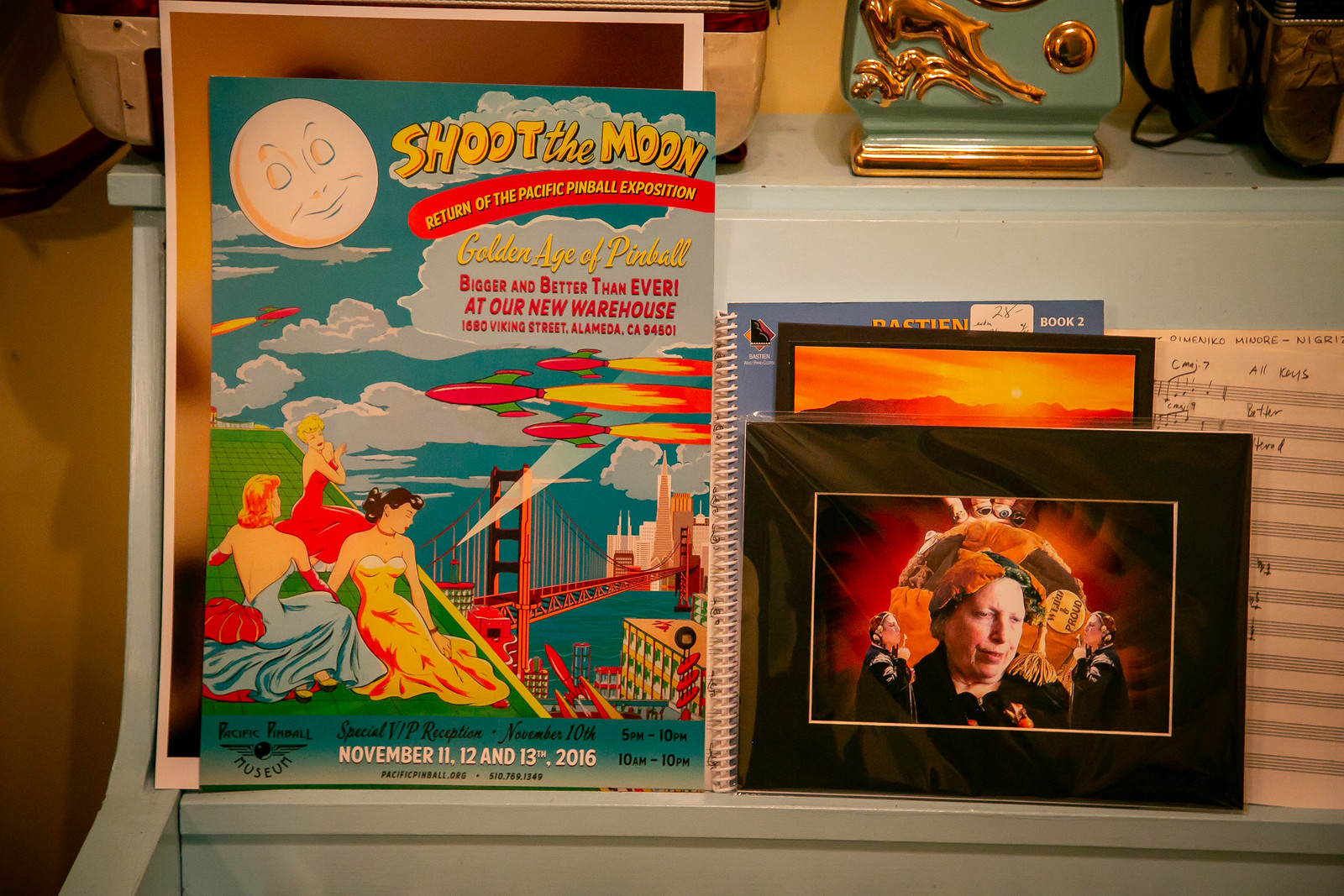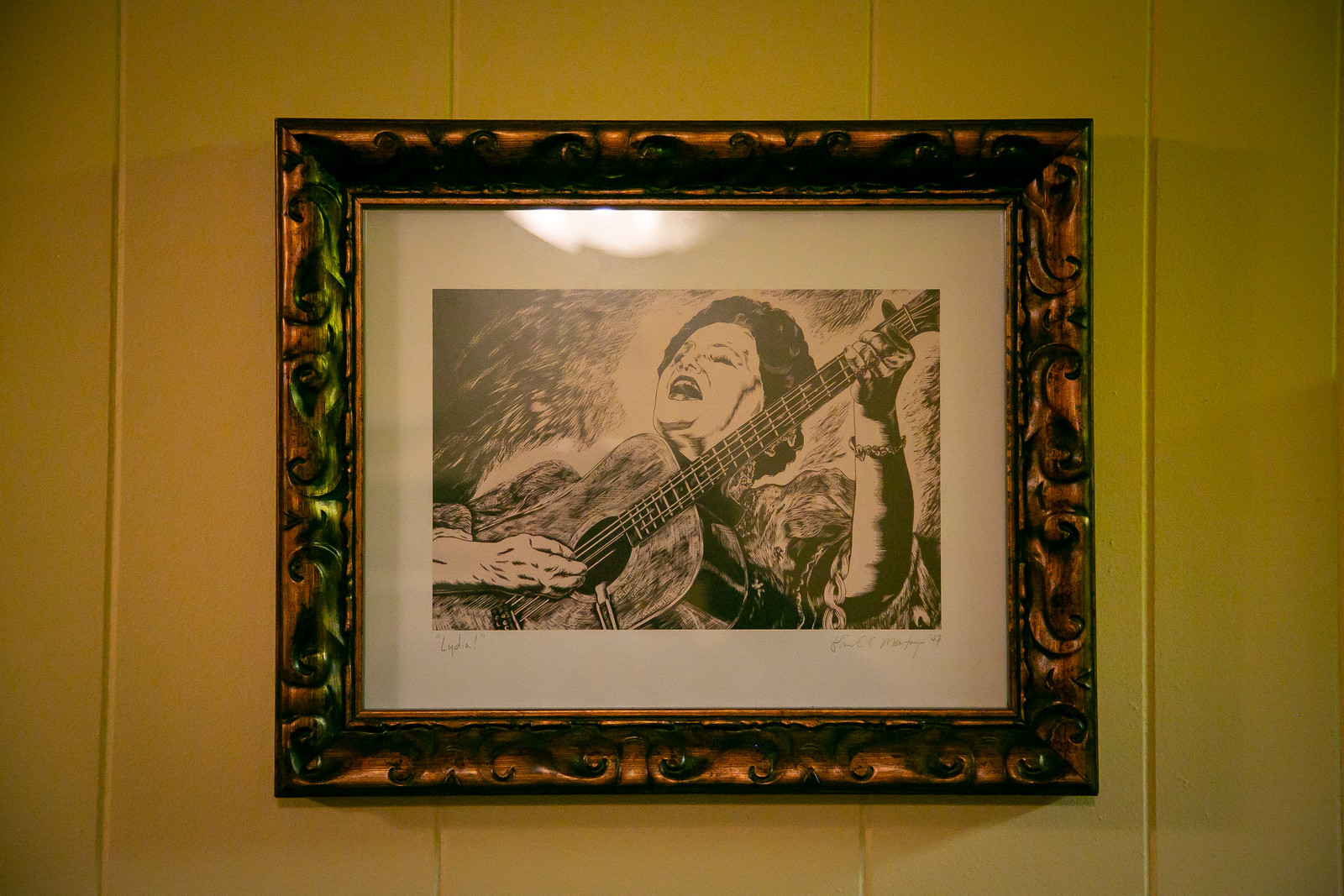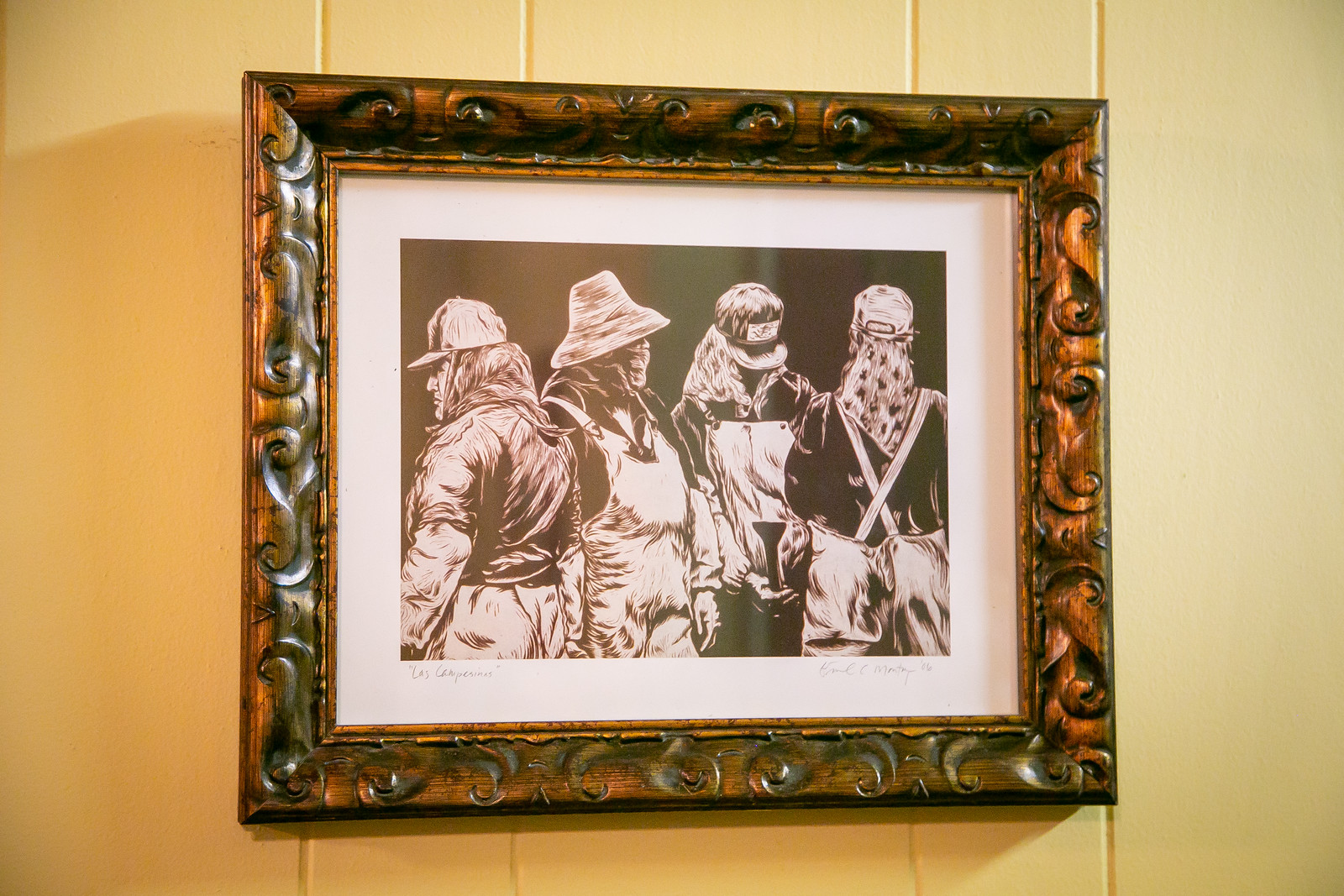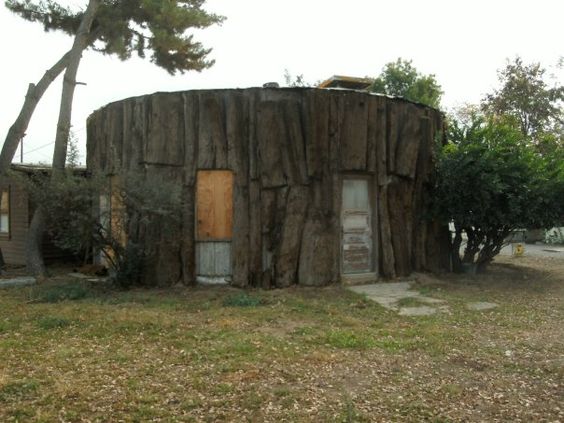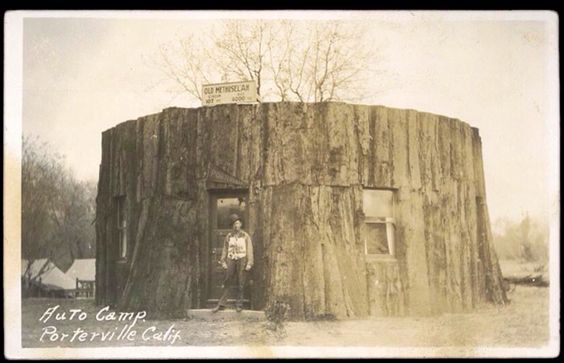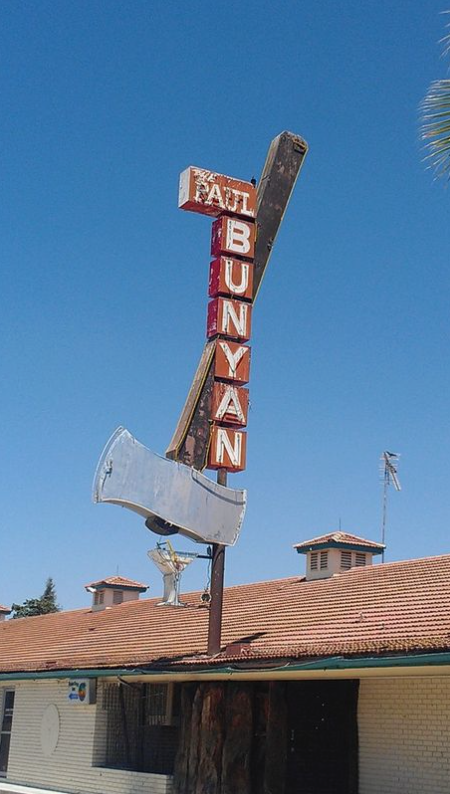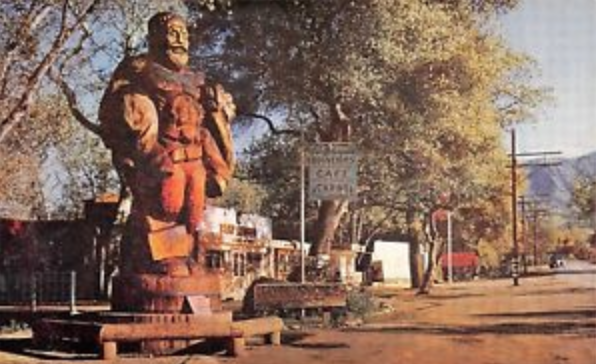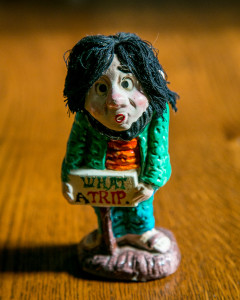The walls of Dorrit’s apartment are bright orange. It works.
Every object in the apartment – every single piece of material culture – is intentional (if that is the right word). Design rules. Let’s start in the mid-century modern (and a little art deco, no?) kitchen.
Dorrit rescued the decorative features of an O’Keefe and Meritt range. I am told that O’ Keefe & Merritt ranges always featured state of art technology. Modern models. Round non-clog burners. Extra large cooking tops. Full/insulated ovens. In-a-drawer smokeless broilers. Non-tip oven racks. Flash lighters. Oven regulators. Condiment sets. Cooking light. Electric appliance plug. Beautiful perfect enamel finishes. Minute minder, measured time clocks. Designed to make cooking a pleasure. Variety of models to suit to any customer and their purse!
What a light!
In a corner in the kitchen – cool color-coordinated trashcan and wall phone.
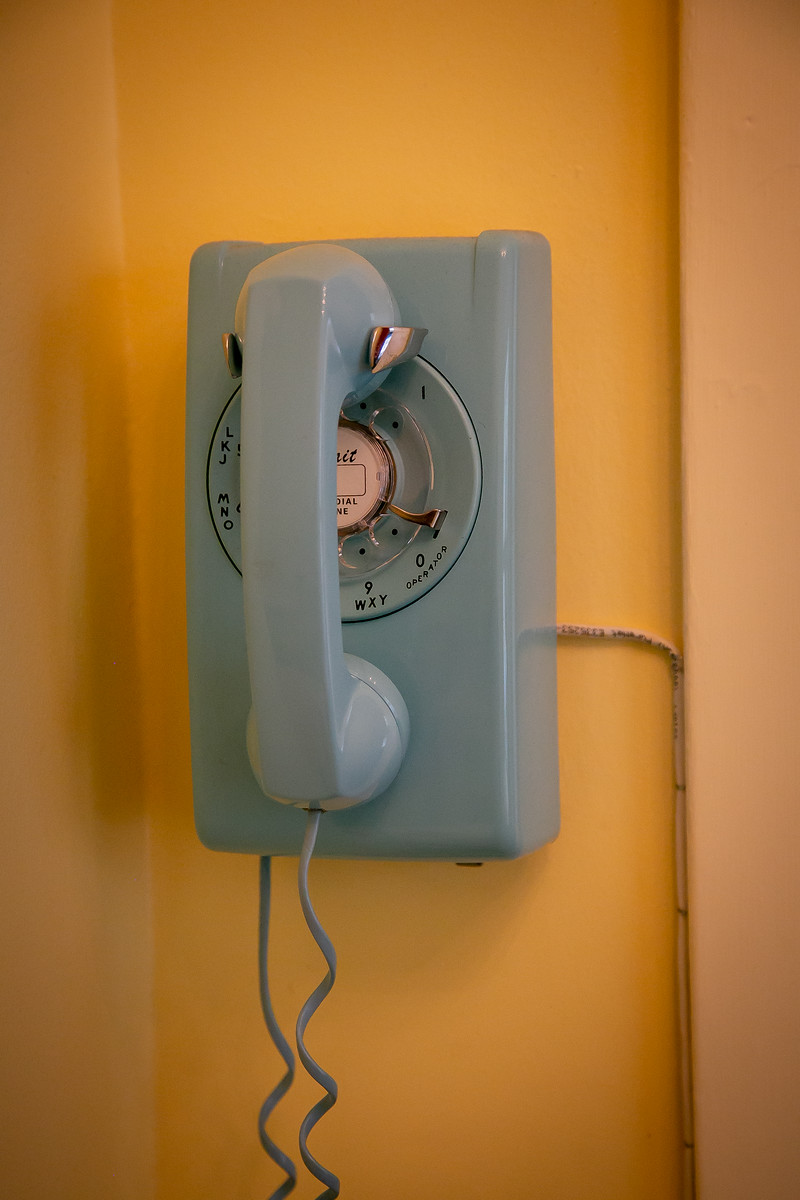 You noticed, I assume, that the phone is a rotary phone. Random fact: My doctor for many years, Alan Greenbaum, had a rotary phone in his office until he retired a few years ago.
You noticed, I assume, that the phone is a rotary phone. Random fact: My doctor for many years, Alan Greenbaum, had a rotary phone in his office until he retired a few years ago.
Her living room – the orange room – is bright (as most orange rooms are) and every little detail screams DESIGN and TASTE and QUIRKY.
This sculpture depicts one of Tom Dunphy’s sisters. Tom lives in the California Apartments. His nom de guerre in the 1960s and 1970s was General Waste-more-land. He was a one-man anti-war guerrilla theater. I will be posting about him soon.
This is a back glass from the Space Ship pinball game. It was a one-player game; The Williams Electronic Manufacturing Company produced 600 units in December 1961. It has two flippers, three pop bumpers, 2 slingshots, 5 standup targets, and two gobble holes. The maximum displayed point score is 8,990,000 points. The replay wheel maximum is 47. There are two bells. It was designed by Steve Kordek, art by George Molentin. Kordek revolutionized the game of pinball in the 1940s by designing what became the standard two-flipper machine. Molentin and Roy Parker, both from Chicago, were the most prolific among the artists who illustrated back glass and playfields.
This is what the Space Ship play field looks like:
This is what the electronics of the upper playfield look like.
Here is why I included these details on Spaceship: (1) including a lot of details is a device used by writers of magical realism, a genre of literature that rocks it for me; (2) there very well may be readers of Quirky Berkeley who dig pinball and would appreciate the background information; (3) I enjoyed playing pinball at the Salinas Greyhound Bus station with Marshall Ganz in the summer of 1979 and I find the game intrinsically quirky; and (4) I liked very much the depiction of pinball in the Who’s Tommy and in he movie Brother from Another Planet – at a repair shop in Spanish Harlem we saw that our hero’s powers include the ability to fix video games and pinball games by touching them.
The most intensely quirky room in Dorrit’s apartment is the bathroom. I have written a post about quirky bathrooms, and you can be Very Sure that these photos will be added with great speed and immediacy.
This utterly awesome ceiling light establishes the theme of the bathroom – cowgirl!
Why cowgirl?
Cowgirls are cool. Cowgirls are tough. Dorrit says that rodeo was the first sport in which a woman could make a living with a sport.
But mostly – cowgirls are cool. Let’s put on Sweetheart of the Rodeo and inspect the bathroom.
John Storey rocked arty here, didn’t he? Cowgirl quirk reflected!
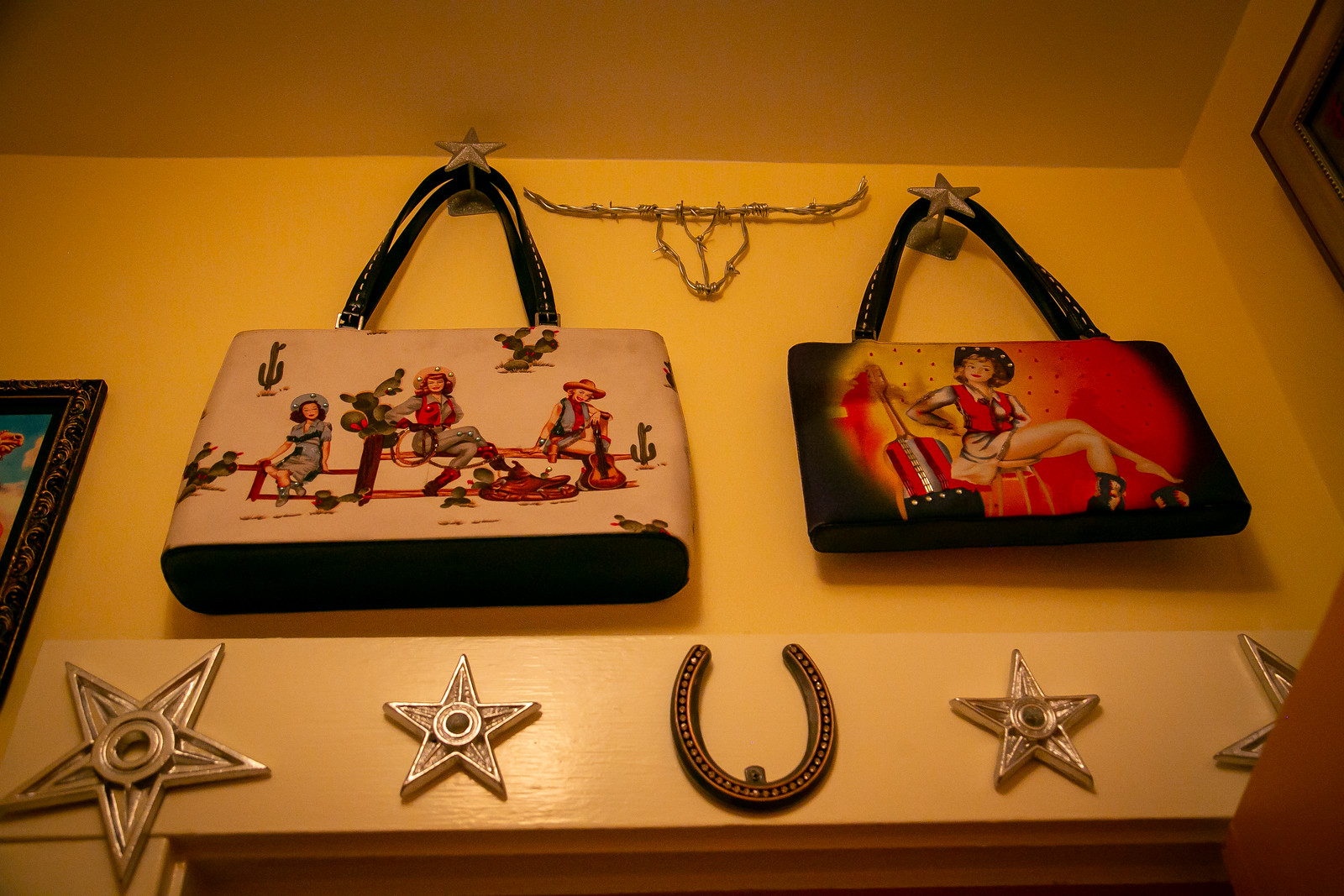 Note the horseshoe over the door. John Storey hates horseshoes and hated every horseshoe photograph he took for my horseshoe post. But professional that he is, he maintained here.
Note the horseshoe over the door. John Storey hates horseshoes and hated every horseshoe photograph he took for my horseshoe post. But professional that he is, he maintained here.
We have one more stop – Dorrit’s building manager office, which I am going to explain.
Before that last stop, a little bit about Dorrit?
I all about simple declarative sentences, as you are about to see.
She was born in Pasadena in 1965 to parents born in Israel. Her grandparents were from the Ukraine and Belarus.
At age six months her family moved to Iowa City where her father studied psychology at the graduate level.
They then moved to Maryville, Missouri, where her father taught at Northwestern Missouri State. Maryville has a population of just over 10,000.
Maryville is a place “where roots run deep,” according to the slogan that runs in wavy script across the city’s official insignia. it is a small, quiet place, tucked away in rural Nodaway County. It was described several years ago as a “lawless hellhole.” Dorrit describes it as “smack dab in the middle of nowhere.”
Her little girl years were in Maryville, smack dab in the middle of nowhere.
She did the first half of 9th grade in Maryville. TIME OUT.
The Spoofhounds?
The Spoofhound was a Plaster of Paris carnival toy from the 1920s. Maryville is now the only school in the country to use the Spoofhound mascot as its mascot. Although originally two words, Maryville uses the closed compound Spoofhound for its mascot. Acrording to Nodway Broadcasting, “Legend has it that the high school received this nickname in the 1920s when the football coach L.E. Ziegler was so angry with the way his squad had looked in practice that as an insult he said they looked like a bunch of “Spoofhounds”. The players mockingly referred to one another by this insult and the name stuck. Maryville’s mascot has evolved over the years from a lovable buffoon “Spoofy” to a snarling “Hound.”
End of time out. After the first half of Dorrit’s freshman year as a Spoofhound, her family moved again.
Next stop – Porterville, California. Porterville is at the southeastern end of the San Joaquin Valley. The the municipal slogan is “The Good Life.”
It’s a small town, famous recently for the fact that most of the nearby unincorporated area of East Porterville has run out of its supply of groundwater.
John Fogerty wrote the song “Porterville” while serving on active duty in the Army. His band recorded this song while they were still using the name The Golliwogs and released it under that name in 1967 on Scorpio Records, a subsidiary of Fantasy. Later that year, Scorpio released it again when the band changed their name to Creedence Clearwater Revival, making it their first single under that moniker. In 1968, the band was transferred to the main Fantasy Records label, which released the first Creedence Clearwater Revival album, including this song on the track list.
The song’s refrain is “I don’t care! I don’t care!”
 Dorrit’s father took a job with the Porterville State Hospital, which has been renamed as the Porterville Developmental Center.
Dorrit’s father took a job with the Porterville State Hospital, which has been renamed as the Porterville Developmental Center.
Dorrit was in ninth grade when she got to Porterville. In Maryville, she had been an awkward kid. “There was no other” there.
She went to Monache High School, one of three in Porterville. The Monache, also known as the Mono or Western Mono, were connected by language with the Eastern Mono and other Paiute Indian groups living on the east side of the Sierras.
At Monache High she found the other – outcasts, gay boys, and artists.
After a year at UC Davis and a year at Porterville Community College, she enrolled at Chico State, majoring in microbiology.
In Chico, she lived-in an apartment over the Senator Theater. The neon sign lit her room at night.
She worked at the Underground Record Store. They bought and sold record albums and had an inventory of new music.
In Chico, Dorrit became her own person.
After college she bought a one-way ticket to Israel where she lived on a kibbutz or two (I dont know the plural!) for a year.
This is Beit HaShita (Hebrew: בֵּית הַשִּׁטָּה, literally “House of the Acacia.”
This is Evron (Hebrew: עֶבְרוֹן) a kibbutz in northern Israel in the western Galilee adjacent to Nahariya
Then she went to London.
She hiked the West Highland Way in Scotland – Slighe na Gàidhealtachd an Iar, 96 miles from Milngavie north of Glasgow to Fort William in the Scottish Higlands.
She moved to New York and worked at Tower Records at Fourth and Broadway.
She moved to Seattle in 1991 and worked on fishing boats in Alaska as the science person on board.
She moved to Guatemala, and then back to Seattle where she worked as a geneticist in a lab. In 1994 she followed the lab to Chapel Hill, North Carolina.
The lab closed and she began to volunteer at Internationalist Books.
Bob Sheldon founded Internationalist Books in 1981. His aim was to provide alternative information during the anti-apartheid movement in the 80s as well as a place to share Marxist literature. When the bookstore was opened, Sheldon described the store’s mission as follows: “We are dedicated to the position that we have no country: we do not support mindless patriotic pleas for ‘national unity,’ nor are we interested in keeping America number one. We support the unity and liberation of oppressed people worldwide and are working toward the day when all oppression and inequality will be removed from the earth.”
On February 21, 1991, Bob Sheldon was shot and killed as he was closing the store for the evening. A collective formed to carry the store’s mission forward. IIt sold Marxist, anarchist, environmental, gay and lesbian, black and minority books.
Dorrit has exceptional executive skills and organizational skills. She was a central figure in keeping the bookstore going. While in Chapel Hill, Dorrit led a do-it-yourself mini after-school program for the kids in the neighborhood. And she drove a cab on the side.
She then went to Chiapas to observe the revolutionary Zapatista movement.
Next stop: San Francisco. There were cheap plane flights there. She came.
She stayed in the house of Faith Petric, a folk singer, activist, and head of the San Francisco Folk Music Club for 50 years. She was referred to as “the Fort Knox of folk music.”
Faith was folk music royalty and was visited by other royalty – Bruce “Utah” Phillips and Pete Seeger to name two.
Faith remains an inspiration for Dorrit.
Dorrit’s organizational skills were next put to use with a consortium of medical marijuana clubs in Berkeley. She moved into the California Apartments in more or less 2001. Her room had once been a stash house for drugs. She had visitors who she didn’t know and couldn’t make happy.
Ownership of the California Apartments changed hands and tenants were having a tough time with the new owners. Dorrit used her dispute resolution skills to build a bridge with the new owners, and then between the new owners and the tenants. In 2005, she was hired as the building manager.
She takes this job very seriously and does it very well.
She created this beautiful garden. The tenants are diverse, part of what she calls an “unintentional community.” She knows them and helps them and learns from them. She believes that we are communal creatures and need contact, but never really experienced community. I will write elsewhere about California Apartments – it is what I think an apartment house should be.
She has a consulting business named Space Rocket. She has done work for the Center for Nonviolent Communication and the Yoga Health Complex and for people of wealth as a high-end personal assistant. “I have a great name for the business and a great logo. I change the business as needed, keeping the name.”
So – though – returning to our tour of Dorrit Quirk, we are in her office at the California Apartments.
Keys! I find this joyful. I think of the keys in the office of the building manager of the Glikbarg Building in Salinas where the United Farm Workers legal department had its offices from 1974 until 1980. And I think of the thousands of keys in each PG&E office when meter readers still read meters. I like the keys.
This is a self-portrait by Debbie Vinograd, the painter sister of poet Julia, who died in early December. Julia lived in the California Apartments.
Dorrit was a dear friend to Julia. She visits Julia in this recent photo. I wrote a post about Julia and her room last year.
Florence lived in the California Apartments for 70 years. I will write about her in another post. Florence didn’t care to have her photo taken.
Dorrit wrote me about music:
“I’m not a very accomplished musician, somewhat more than a beginner. I’m mostly self-taught but took a few lessons here and there over the years. I did work very hard at getting better for a number of years – went to music camps, workshops, practiced for hours on end, etc. I would not say that I have any musical talent, but with some hard work I managed to be able to play some tunes.
My real skill is that I’m a great organizer so I managed to have bands and attract people who were far better musicians than me. I did all the work of organizing the rehearsals (including always having some tasty treats for the band), choosing the music to play, scheduling gigs, etc.
There were a couple of iterations of my klezmer bands – The first was Villiage Yiddiots, and then later it was Heavy Shtetl. I had wanted the band to be called Five Blind Moyls, but my bandmates protested. The whole thing started as a way for me to connect with my cultural identity, but quickly morphed into something bigger. I found a copy of my band’s philosophy and pasted it below.”
The band’s philosophy: “In an age when so much music is produced as a commodity, the members of Heavy Shtetl have turned to klezmer, a musical tradition that was meant to accompany us in life’s activities. Many klezmer tunes were for played for specific community events such as weddings and other celebrations. Heavy Shtetl envisions a world filled with music to accompany people in their daily lives. We contribute to this vision by offering joyous and poignant music with haunting melodies to recreate the social roots of music. When we create this musical soundtrack to our lives, we provide more opportunities to be engaged with our neighbors and build community, which contradicts the pervasive capitalist paradigms that govern much of the world around us.”
She described the performance ethos of the band: “We strive to be not just a musical group, but to embody the theatrical spirit of Yiddish culture (Yiddishkayt) using Borsht-Belt humor, flashy costumes and on-stage antics, as well as political and social commentary.” This isn’t a bad description of many facets of Dorrit’s life.
Anyways – hence the accordions.
Resting on the piano is a photograph of the aforementioned Julia Vinograd, our poet.
The block prints are by Emmanuel Montoya, and artist and muralist. The top print depicts Lydia Mendoza. The bottom print is Las Campesinas -The Farm Workers. Lydia Mendoza sang in the style of Tejano, conjunto, and traditional Mexican-American music. She is known as “La Alondra de la Frontera” -“The Lark of the Border.”
But – there you have it, a sampling of Dorrit Gesuri’s quirk. I am working on another post with and about her, based on the California Apartments – its history and its character and stories of residents and its perfection as an apartment house.
As I was finishing this post, the Quirky Berkeley Judges Committee was holding its annual meeting. As an exercise, I asked them to rate Dorit Gexhuri’s quirkiness.
It didn’t take them long
That’s how I feel.
I showed the draft post to my friend. He said, “I mentioned to Gabby that you were writing this and that you mentioned Porterville. When I visited you guys in on Gage Street in Bakersfield in ’73 he and I went over to Porterville one Sunday. I think you were off somewhere with Cody. He sent me these photos and a postcard from that trip:”
I asked my friend to thank Gabby for these photos and then asked my friend what he thinks of this post about Dorrit and her quirkiness?


